Special Report
Poorest Town in Every State
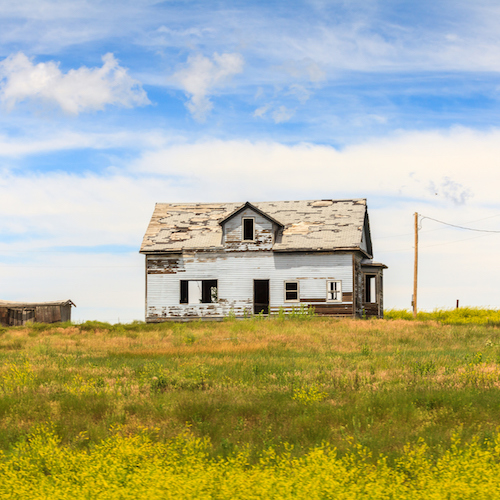
Published:
Last Updated:

Approximately 46 million Americans live in poverty, according to the federal government. Tens of millions more do not live below the poverty line, but nonetheless face financial difficulties living in low-income households.
Wealth is not distributed evenly throughout the country. In some parts of the United States, low incomes and poverty are nearly nonexistent, while poverty is pervasive in others. A typical household in Scarsdale, New York earns nearly a quarter of a million dollars a year, or nearly 15 times the income of a typical household in Centreville, Illinois, of $16,553.
[in-text-ad]
Each state economy is different, and some state populations are, on the whole, far more affluent. But in every state there is at least one town where residents live on incomes well below statewide and nationwide median incomes.
Click here to see the poorest town in every state.
The towns on this list have several notable economic characteristics in common. Educational attainment rates, for example, are frequently indicative of a population’s ability to earn wages above poverty level. In all 50 of the poor towns on this list, the bachelor’s degree attainment rate is lower than the national rate of 29.8%. In all but one town on this list, the college attainment rate is also below the respective state rate.
While real estate prices in larger cities can be prohibitively expensive, in towns and smaller cities, home values tend to reflect how attractive a region is for potential residents as well as the incomes of current residents. In all but two of the poor towns on this list, the typical home is worth less than the national median home value of $178,600. In many cases the typical home is worth less than half the national median.
While each of the towns on this list shares the distinction of having the lowest median income in their state as well as many of the characteristics of poor areas, poverty is much more pervasive in some of the towns on this list.
Ketchikan, Alaska’s poorest town, has a median household income of $53,111 a year, only a few hundred dollars shy of the national median, but more than triple the income of income of Centreville, Illinois, at $16,553. The share of residents living below the official poverty line ranges from 8.6% in Schofield Barracks, Hawaii to 54.2% in San Joaquin, California.
Some of these towns have mitigating factors that lessen the severity of poverty. Some are statewide, such as in Alaska, where residents residents are supported by a statewide oil revenue stipend, ensuring a steady income for every resident. This helps explain why the state’s poorest town is still relatively affluent compared to the other towns on this list.
Locally, the economic makeup of a town can also have a significant impact on how incomes are distributed, and how pervasive poverty is.
Several of the towns on this list, including Schofield Barracks, are military bases that are also Census designated places. These places tend to have low median incomes, likely in part because military pay tends to be relatively low. However, while these soldiers are earning less than many Americans, they are paid enough to remain out of poverty. Schofield Barracks has a poverty rate of just 8.6%, lower than the national rate of 15.5%. Also, because so many residents are government employees, salaries at the upper end of the range are lower. The two towns that are military bases on this list have the most even income distribution in the country.
In the absence of a large employer providing relatively stable, even income, poverty is more common. San Joaquin, California’s poorest town, is in the San Joaquin valley, an area heavily dependent on agriculture and characterized by extremely low-income and inconsistent agriculture jobs.
To determine the poorest town in each state, 24/7 Wall St. reviewed median household incomes in every town with a population between 1,000 and 25,000 in each state from the U.S. Census Bureau’s American Community Survey. All social and economic figures are based on five-year estimates for the period of 2011-2015. To control for potential data errors that can arise in low population areas, we did not consider towns where the margin of error at 90% confidence was greater than 10% of the point estimate of both median household income and population. We considered the percentage of adults who have at least a bachelor’s degree, the share with a high school diploma, the towns’ poverty rates, uninsured rates, and median home value — all from the ACS. The percentage of housing units that are owned by their occupants — referred to as the homeownership rate — also comes from the ACS. Regional price parity by state is for the most recent available year from the Bureau of Economic Analysis.
These are the poorest town in every state.
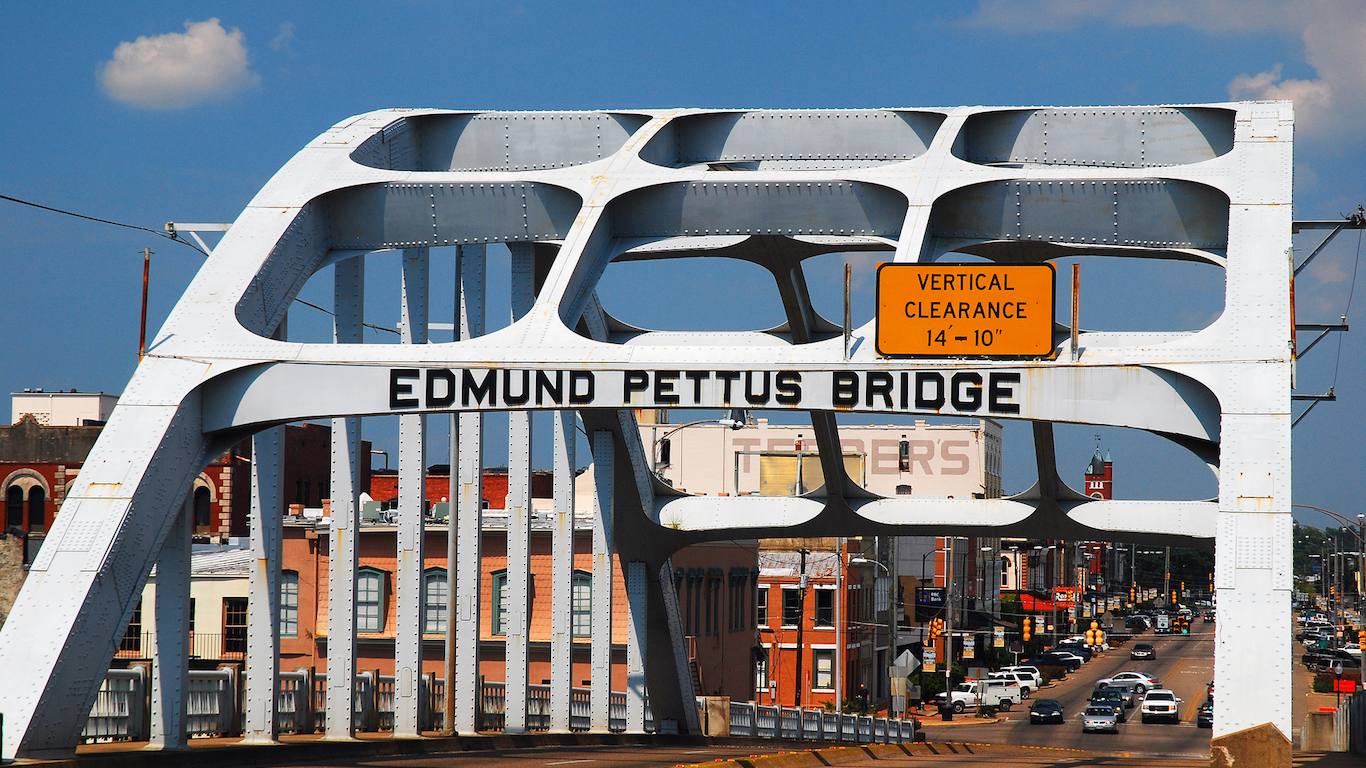
1. Selma, Alabama
> Town median household income: $22,414
> State median household income: $43,623
> Town poverty rate: 41.9%
> Town population: 19,987
Selma is the poorest town in one of the poorest states. The typical Selma household earns just $22,414 a year, well below the $43,623 median income statewide. Like many towns on this list, poverty is relatively common in Selma. Some 41.9% of residents live below the poverty line, more than double Alabama’s 18.8% poverty rate.
[in-text-ad]
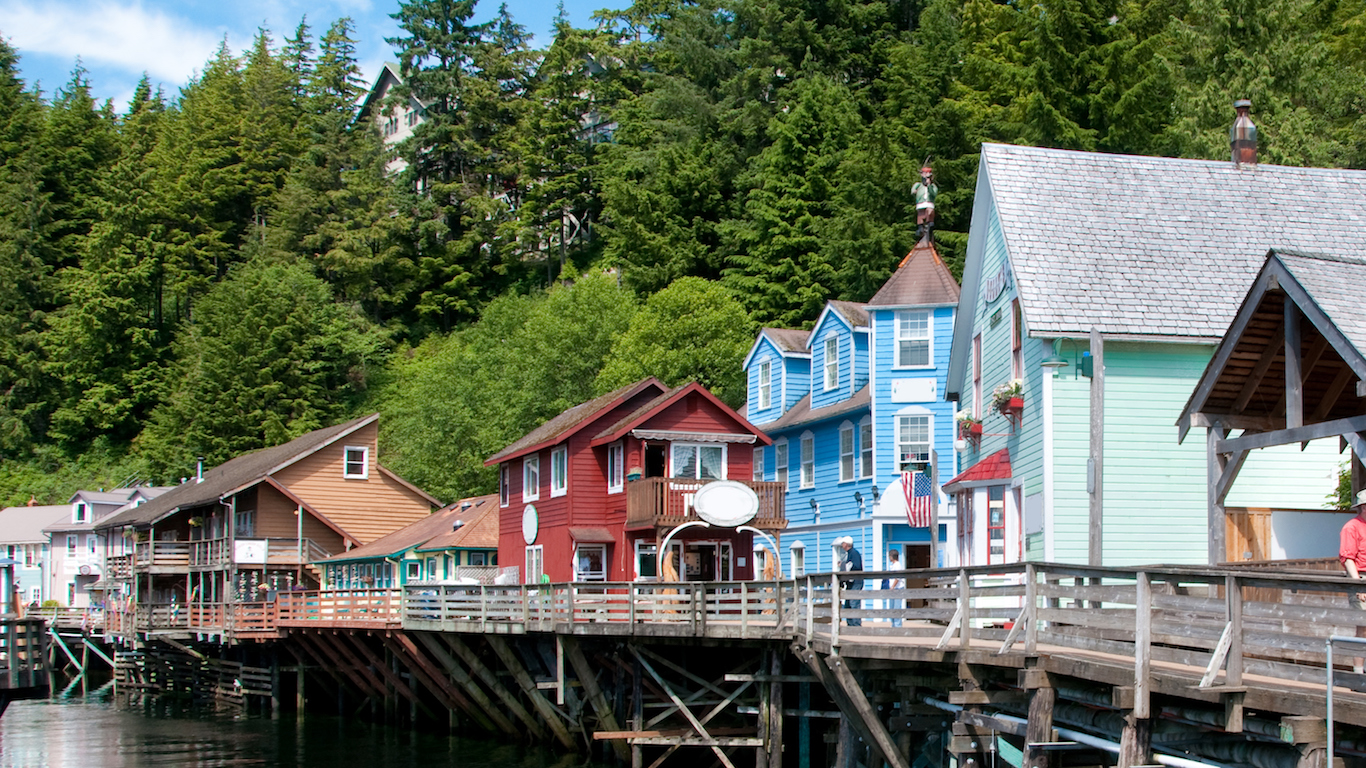
2. Ketchikan, Alaska
> Town median household income: $53,111
> State median household income: $72,515
> Town poverty rate: 16.6%
> Town population: 8,197
Alaska is one of the wealthiest states in the country, and even residents of Ketchikan — the state’s poorest town — are better off financially than many Americans. The median household income in Ketchikan is $53,111 a year, roughly in line with the $53,889 national median income. One factor helping all Alaskans stay financially afloat is the Alaska Permanent Fund. While the dedicated fund — which pays all qualified state residents a share of annual state oil revenues — has decreased in the wake of falling petroleum prices, the dividend was worth $1,022 in 2016.
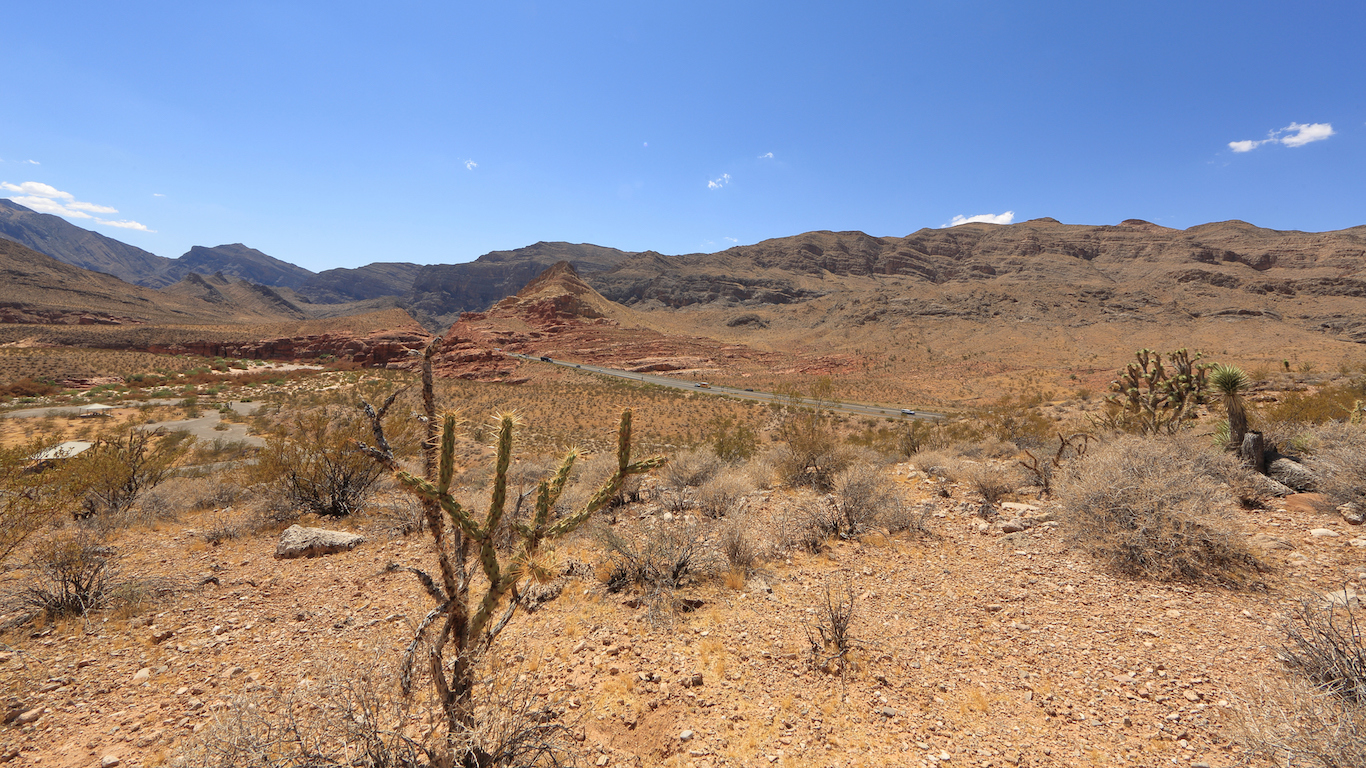
3. New Kingman-Butler, Arizona
> Town median household income: $27,675
> State median household income: $50,255
> Town poverty rate: 30.8%
> Town population: 11,859
The median household income in New Kingman-Butler — Arizona’s poorest town — is only $27,675 a year, slightly more than half the statewide median income. In addition to incomes, property values in the town are well below what is typical across Arizona. The typical home in New Kingman-Butler is worth just $50,800, less than one third of the statewide median home value of $167,500.
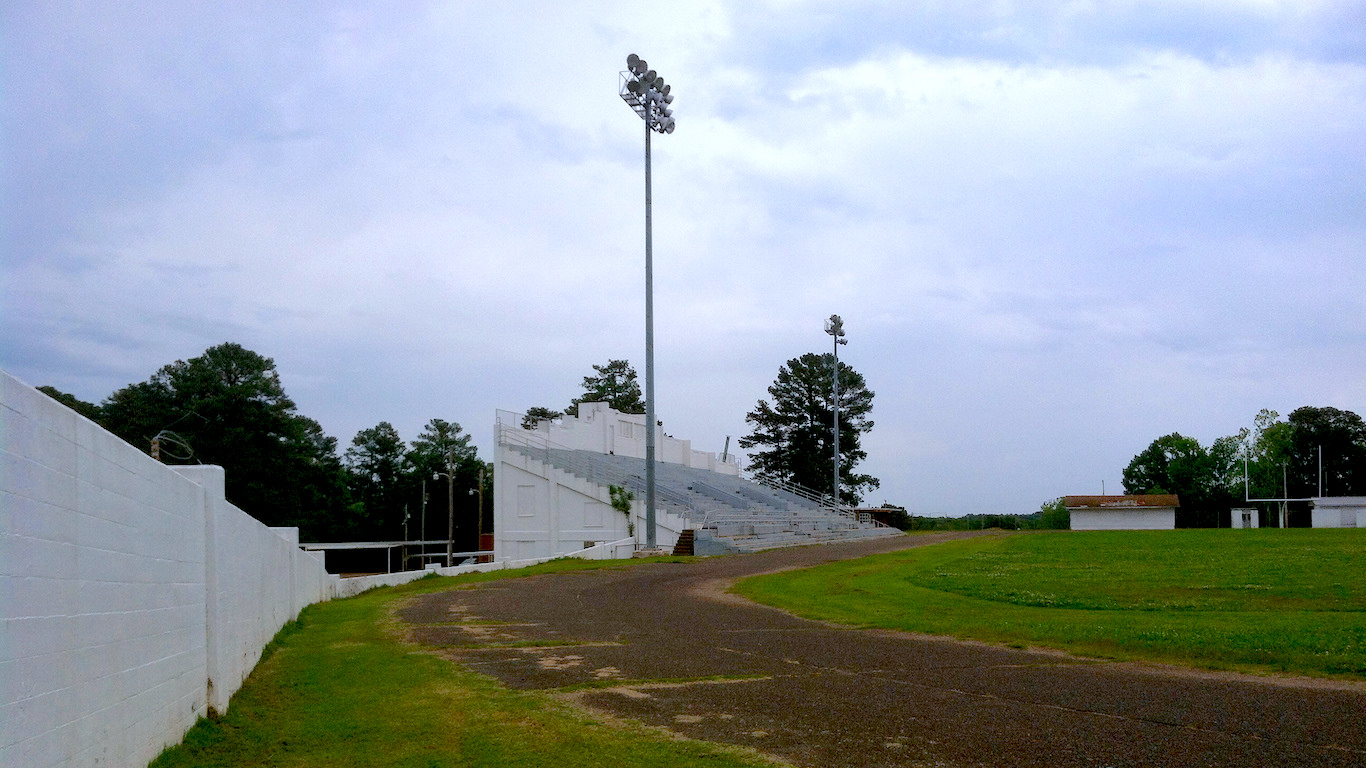
4. Camden, Arkansas
> Town median household income: $25,256
> State median household income: $41,371
> Town poverty rate: 31.4%
> Town population: 11,683
Camden, Arkansas is the poorest town in one of the poorest states. Some 31.4% of Camden’s population lives below the poverty line, more than twice the 15.5% national poverty rate. High paying jobs often require higher educational levels, and only 16.3% of Camden’s adult residents have a bachelor’s degree. In comparison, 21.1% of Arkansas adults have a four-year college degree.
[in-text-ad-2]
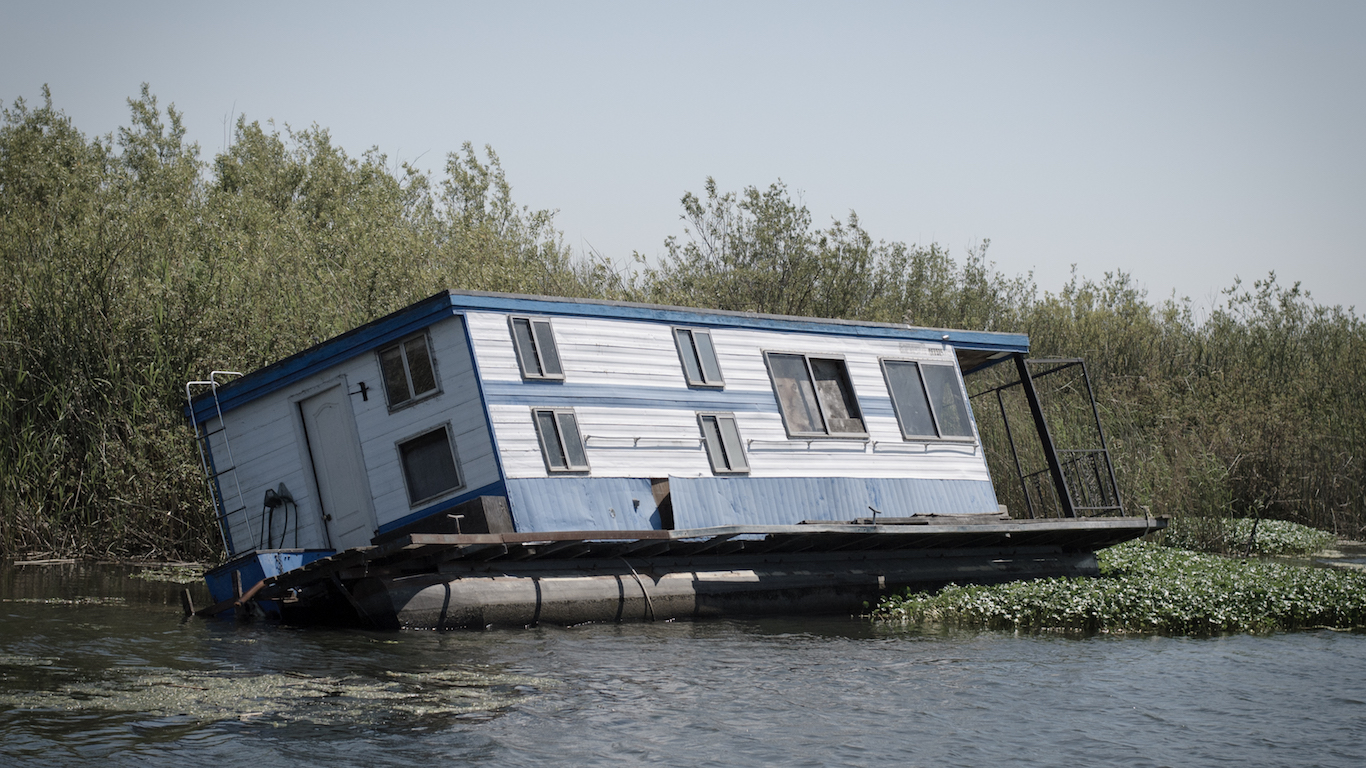
5. San Joaquin, California
> Town median household income: $24,437
> State median household income: $61,818
> Town poverty rate: 54.2%
> Town population: 4,008
In the central California town of San Joaquin, the typical household earns only $24,437 a year, and over half of the population lives in poverty. In comparison, 16.3% of Californians live in poverty, and the statewide median household income is $61,818 a year.
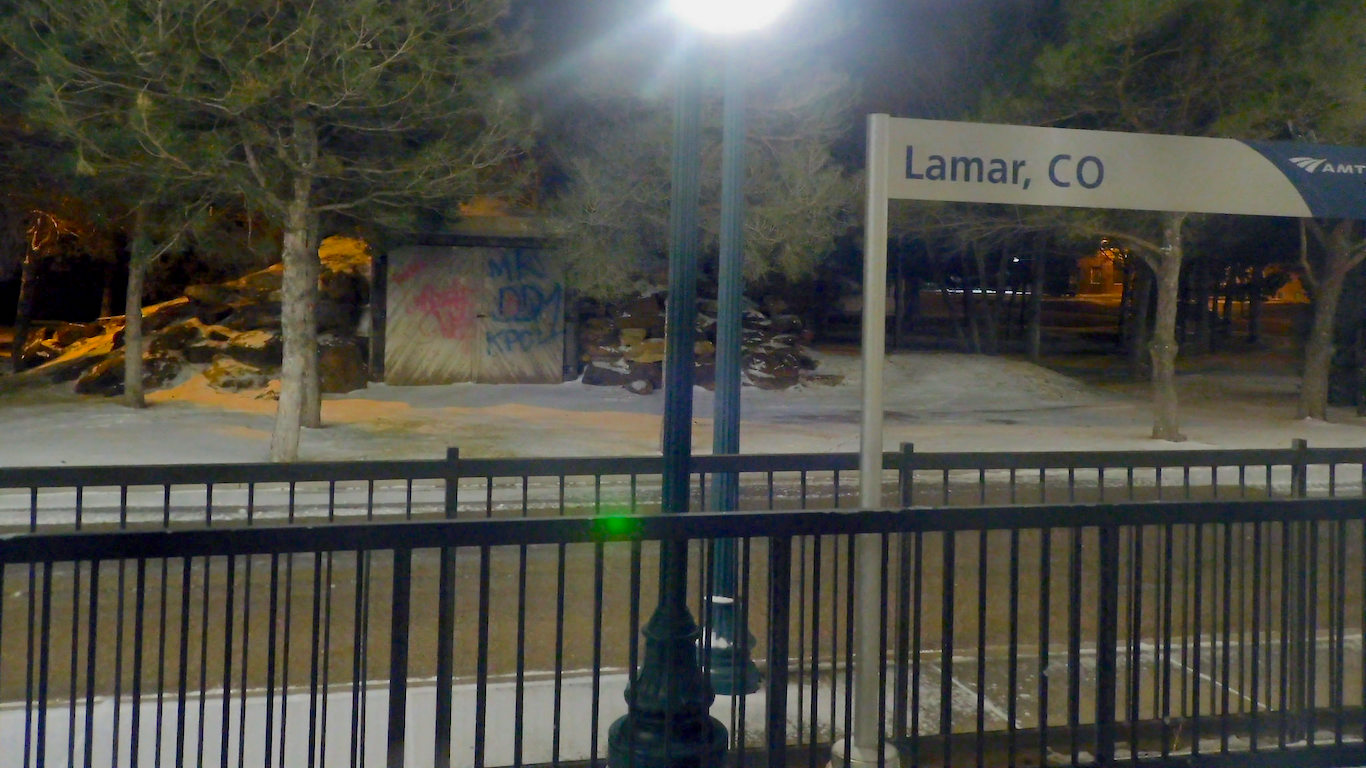
6. Lamar, Colorado
> Town median household income: $35,487
> State median household income: $60,629
> Town poverty rate: 20.3%
> Town population: 7,744
Some 38.1% of adults in Colorado have at least a bachelor’s degree, the second largest share of any state. Higher educational attainment rates often lead to higher incomes, but not all parts of Colorado are home to large shares of college-educated adults. In Lamar, the state’s poorest town, only 11.9% of adults have a four-year college degree, one of the smallest such shares in the state.
[in-text-ad]
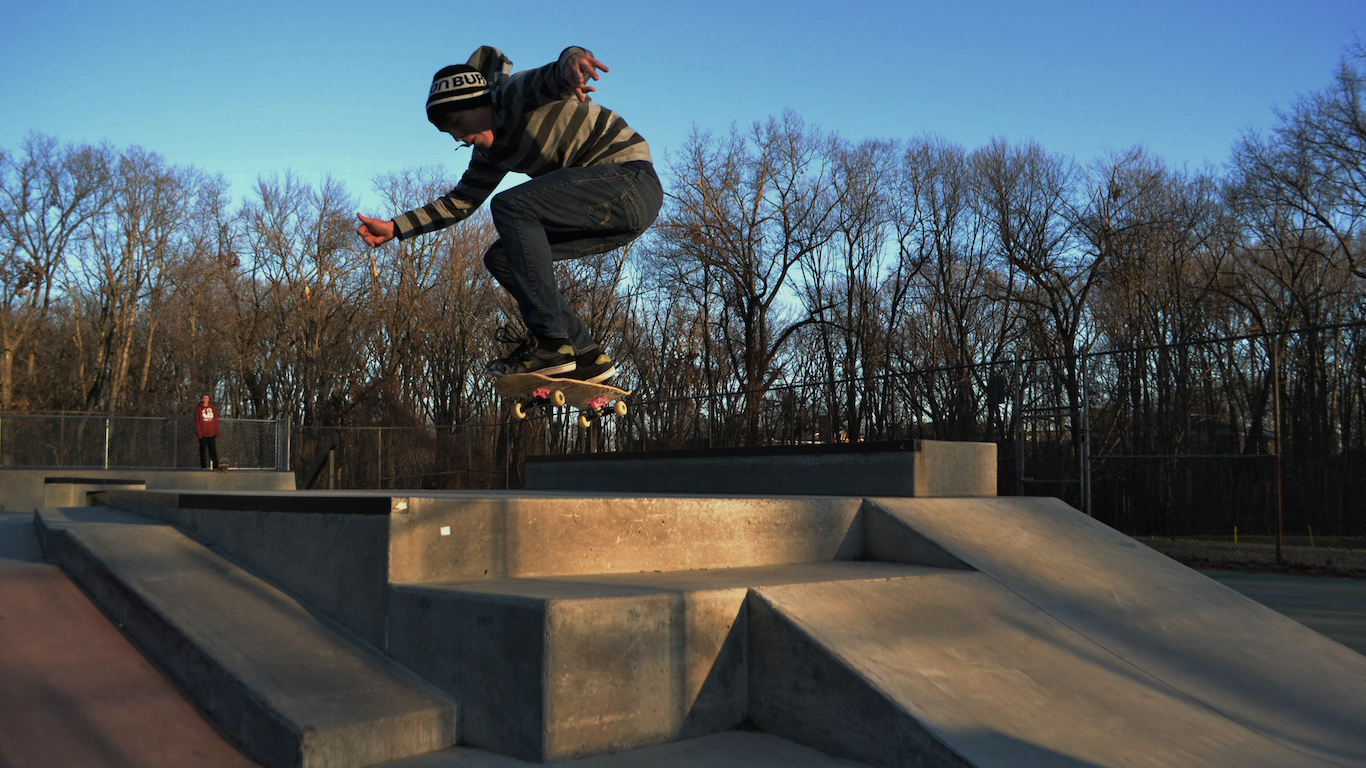
7. Rockville, Connecticut
> Town median household income: $36,778
> State median household income: $70,331
> Town poverty rate: 18.0%
> Town population: 7,459
In Rockville, Connecticut, the typical household earns only $36,778 year — roughly half the median income statewide. With lower incomes, residents are more likely to rely on government assistance. More than one in four Rockville residents received food stamps in the last year, more than double the 12.1% statewide recipiency rate.
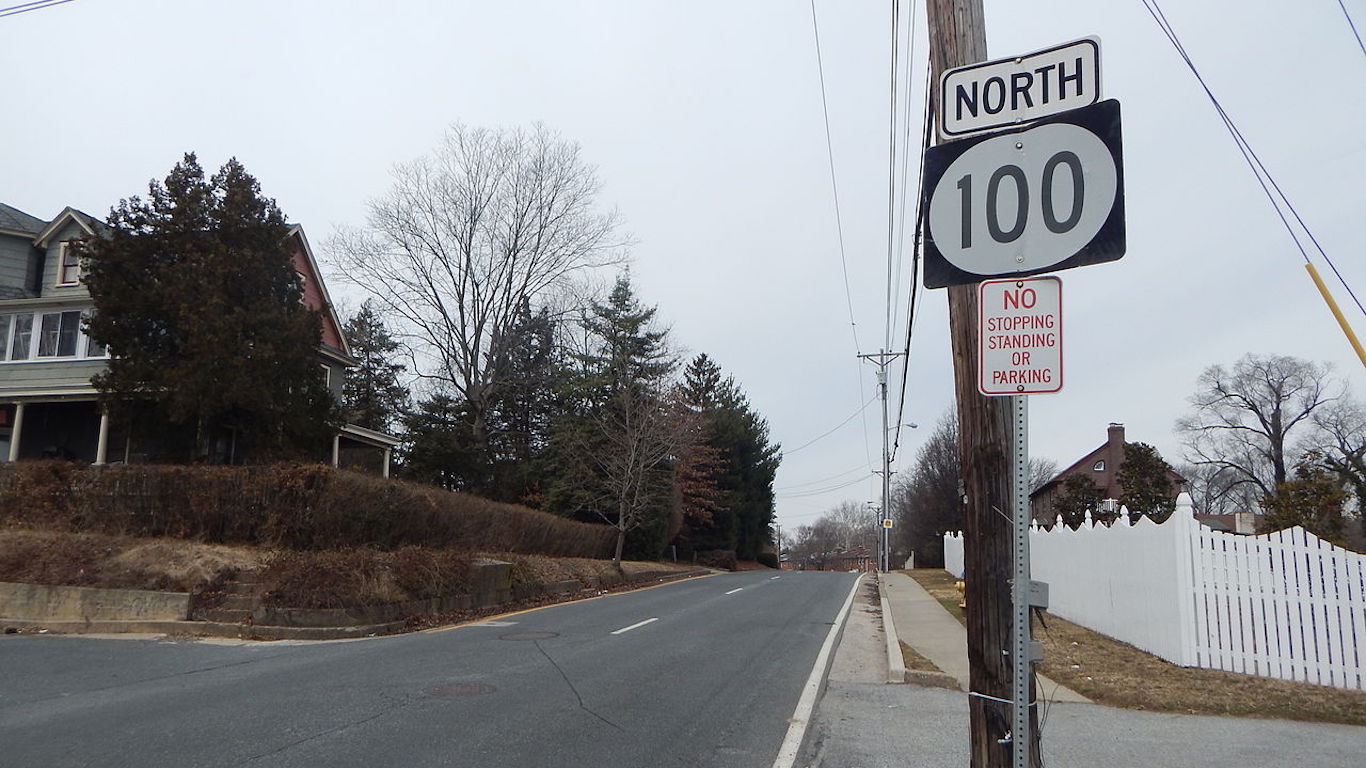
8. Elsmere, Delaware
> Town median household income: $47,704
> State median household income: $60,509
> Town poverty rate: 10.3%
> Town population: 6,154
Poverty is not evenly distributed throughout the country, and in some states even the poorest town is relatively well off. In Elsmere, Delaware’s poorest town, just 10.3% of residents live in poverty, lower than the national rate of 15.5%. Still, Elsmere compares unfavorably to the rest of the nation and the state in several measures that are often related to income. For example, just 15.9% of the town’s adult population has a bachelor’s degree, about half the comparable national and state rate.
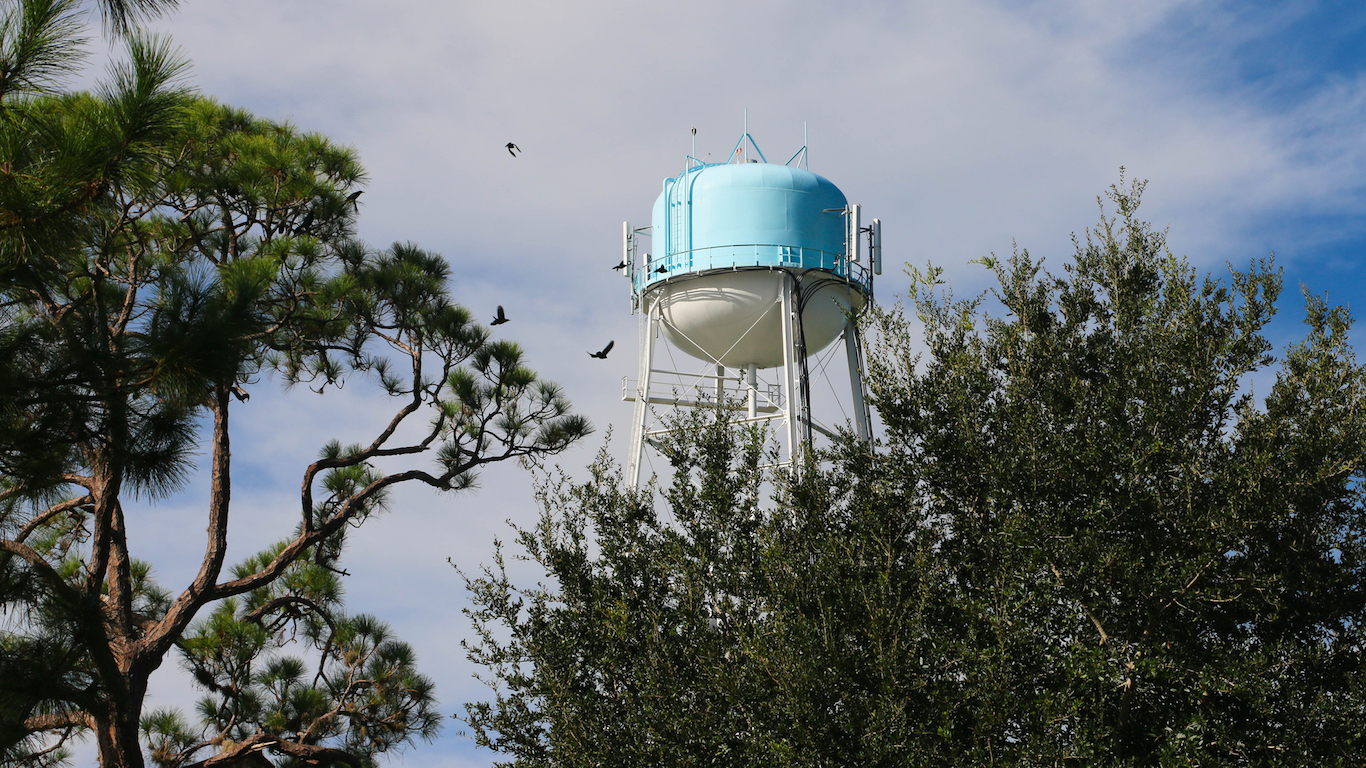
9. Sebring, Florida
> Town median household income: $25,663
> State median household income: $47,507
> Town poverty rate: 30.2%
> Town population: 10,371
Incomes tend to be slightly lower in Florida than they are nationwide. The typical Florida household earns $47,507 a year, less than the $53,889 national median income. In Sebring, Florida, the typical household earns only $25,663 a year, less than half the national median household income.
With lower incomes, Sebring residents are more likely to rely on government assistance. Some 30.2% of the town’s population receives food stamps, nearly double the statewide recipiency rate.
[in-text-ad-2]
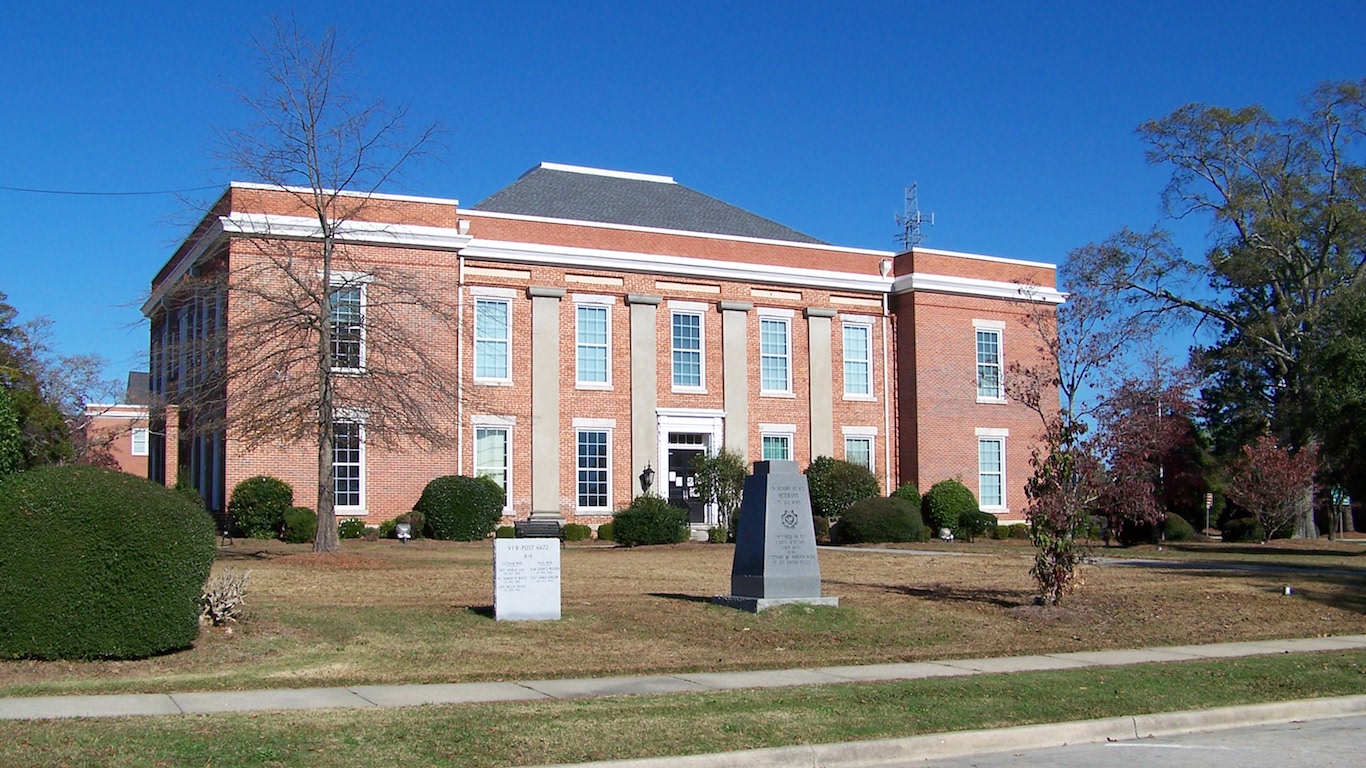
10. Thomson, Georgia
> Town median household income: $21,425
> State median household income: $49,620
> Town poverty rate: 40.1%
> Town population: 6,697
The typical household in Thomson earns only $21,425 a year, less than half the median income of $49,620 a year across Georgia. As is the case with many towns on this list, poverty is relatively common in Thomson. Approximately 40% of the town’s 6,700 residents live below the poverty line, more than double Georgia’s 18% poverty rate.
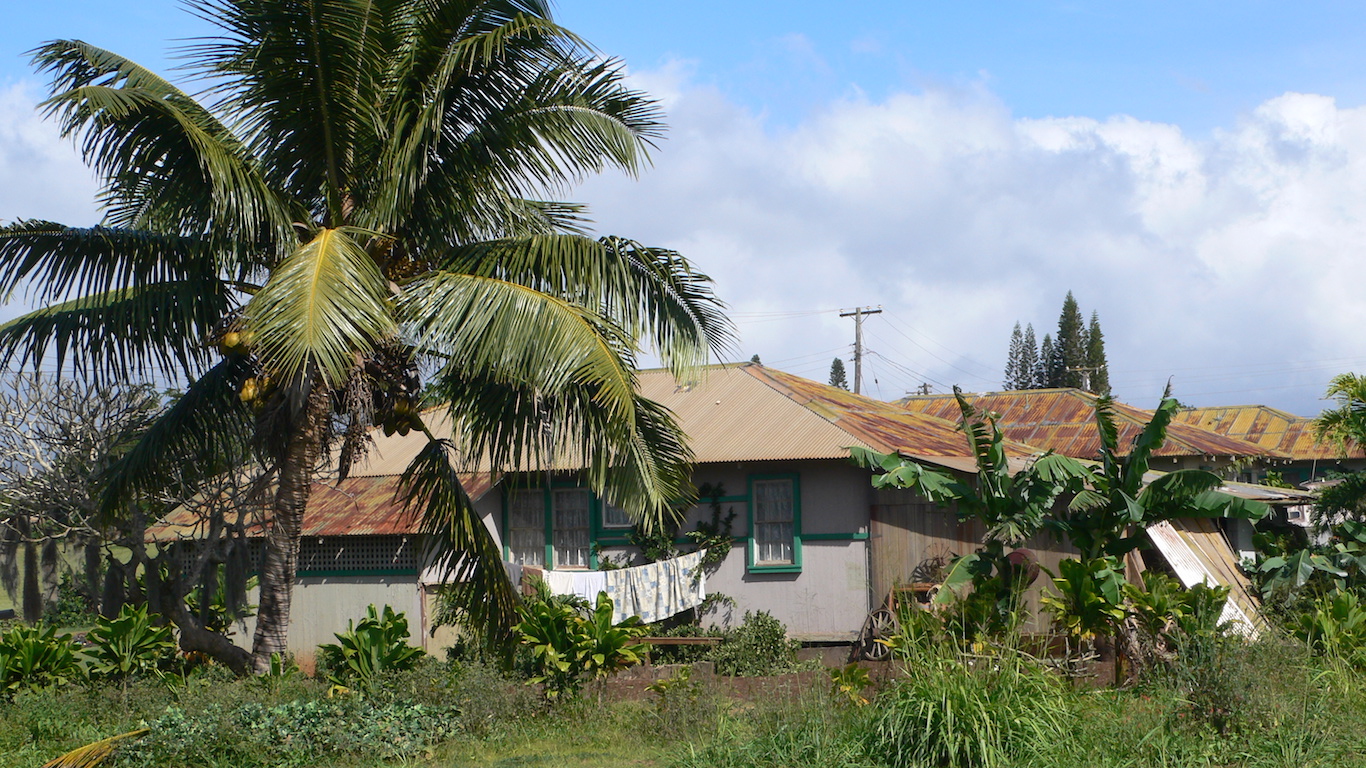
11. Schofield Barracks, Hawaii
> Town median household income: $52,934
> State median household income: $69,515
> Town poverty rate: 8.6%
> Town population: 20,858
Schofield Barracks is unique from other towns on this list. Over half of the town’s adult residents serve in the military. While enlisted personnel may earn relatively low incomes, few appear to be at risk of poverty. Due in part to the area’s unique population, Schofield Barracks is the only town on this list with a lower poverty rate than both the state and the nation. Some 8.6% of the Schofield Barracks population lives in poverty, compared to 11.2% of Hawaiians and 15.5% of Americans.
[in-text-ad]
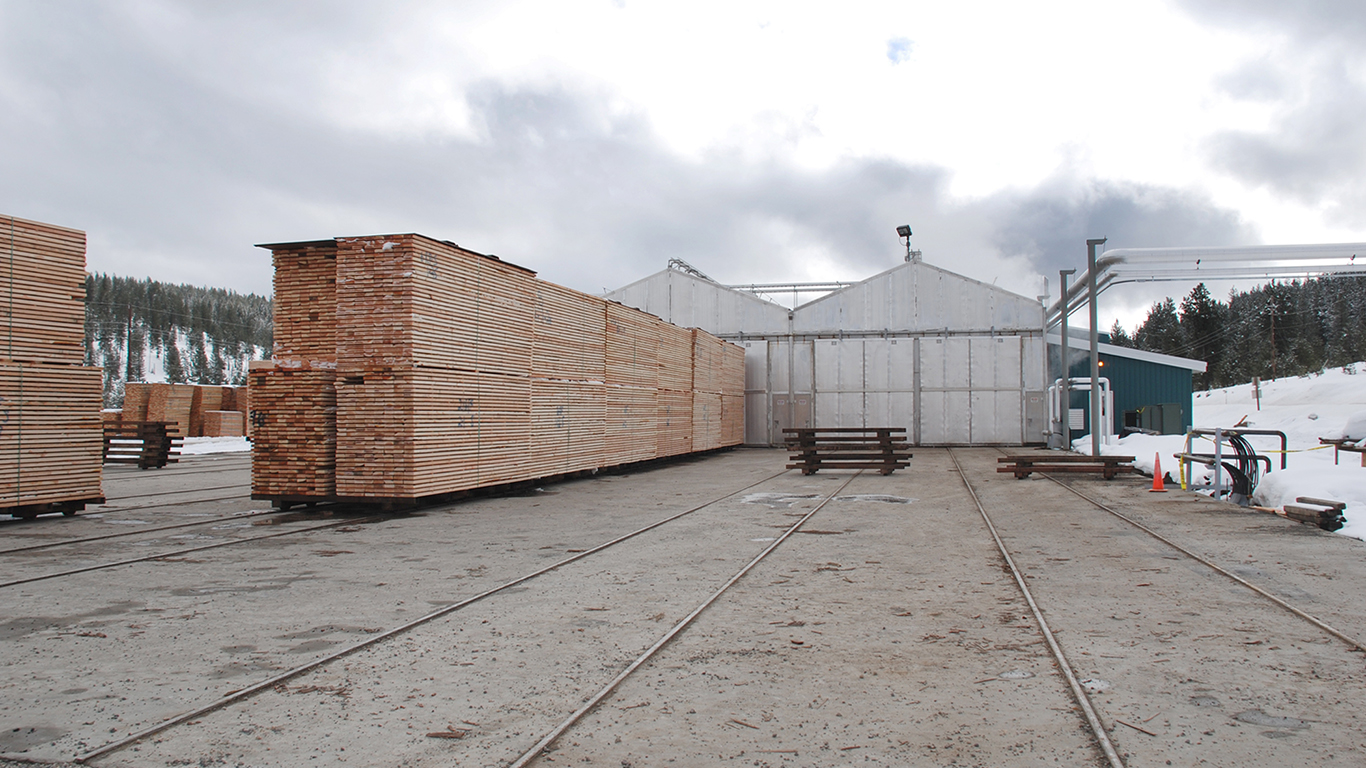
12. Emmett, Idaho
> Town median household income: $27,722
> State median household income: $47,583
> Town poverty rate: 26.6%
> Town population: 6,548
Those who have a college education are more likely to find steady work and avoid living in poverty. In Emmett, Idaho the median household income is $27,722 a year, the lowest in the state. Low incomes may be partially the result of low educational attainment. Only 16.4% of the adult population have at least a bachelor’s degree, nearly 10 percentage points below the state rate and just slightly more than half the comparable national proportion.
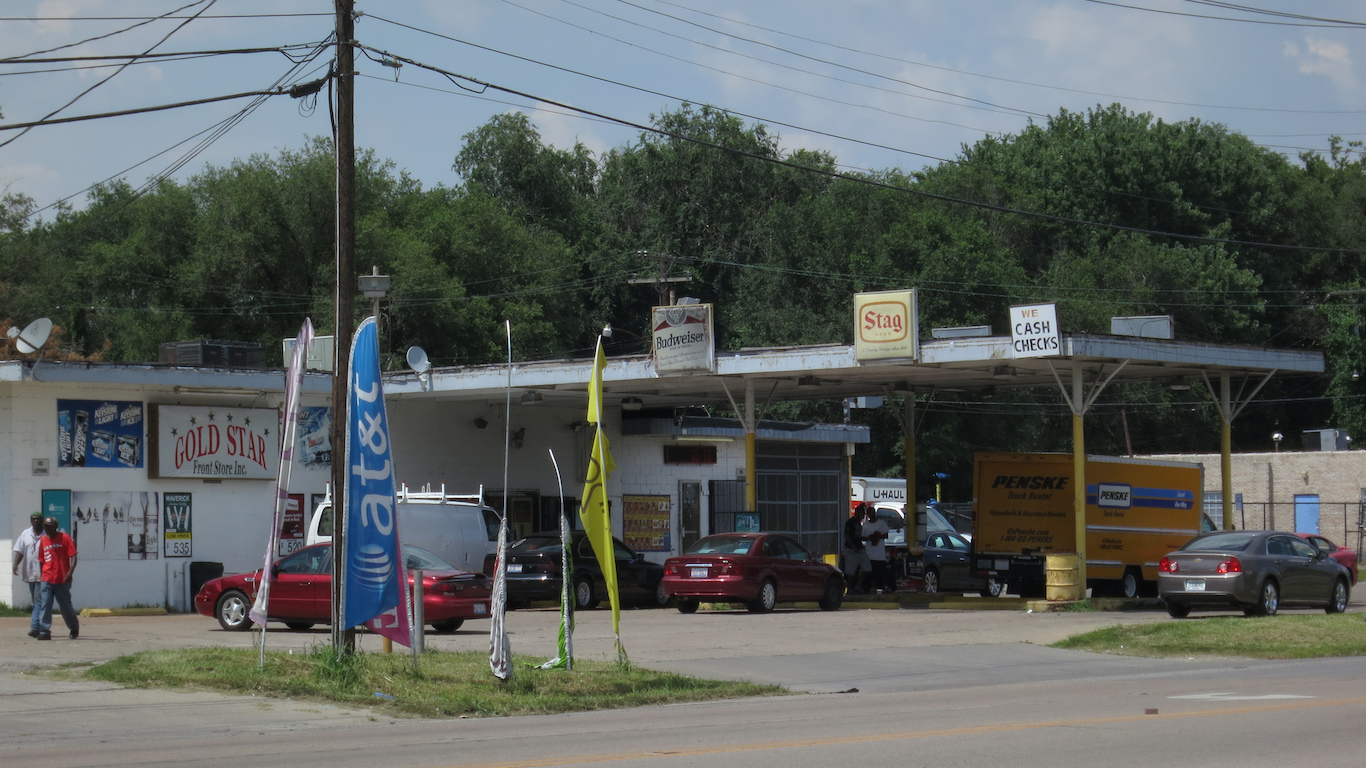
13. Centreville, Illinois
> Town median household income: $16,553
> State median household income: $57,574
> Town poverty rate: 47.8%
> Town population: 5,142
Centreville is not only the poorest town in Illinois, but also the poorest in the country. The typical household income of $16,553 a year is less than one-third the national median annual household income of $53,889. The typical household in Winnetka, Illinois’ wealthiest town, earns an income nearly 13 times greater than in Centreville.
Home values in a given area often closely reflect the area’s relative affluence. In Centreville, the typical home is worth less than $50,000, less than a third of the state’s median home value of $173,800.
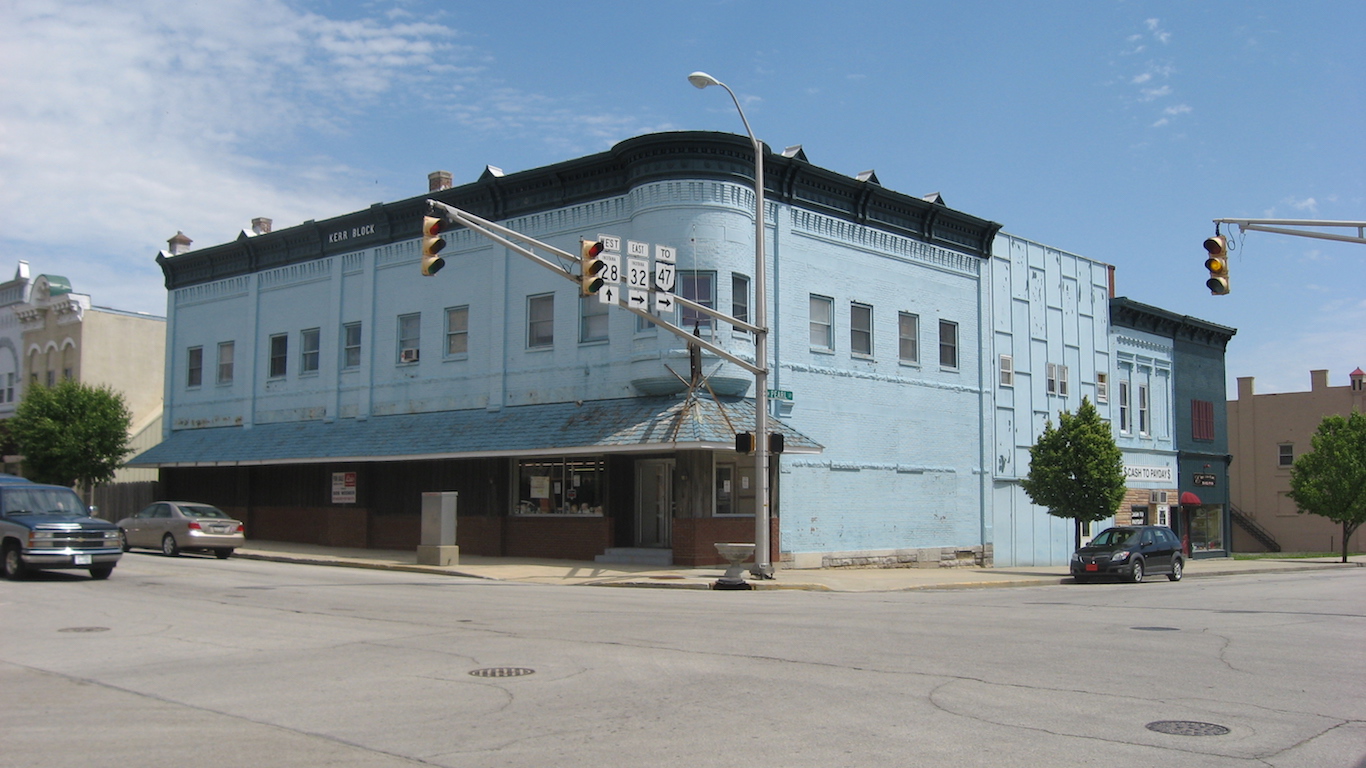
14. Union City, Indiana
> Town median household income: $31,238
> State median household income: $49,255
> Town poverty rate: 31.2%
> Town population: 3,486
Like many low income towns, poverty is a considerable problem in Union City. Some 31.2% of the town’s population lives below the poverty line, more than double the 15.4% statewide poverty rate. Low incomes mean more people depend on government assistance. About one in four Union City residents receive food stamps compared to only 12.5% of Indiana residents.
[in-text-ad-2]
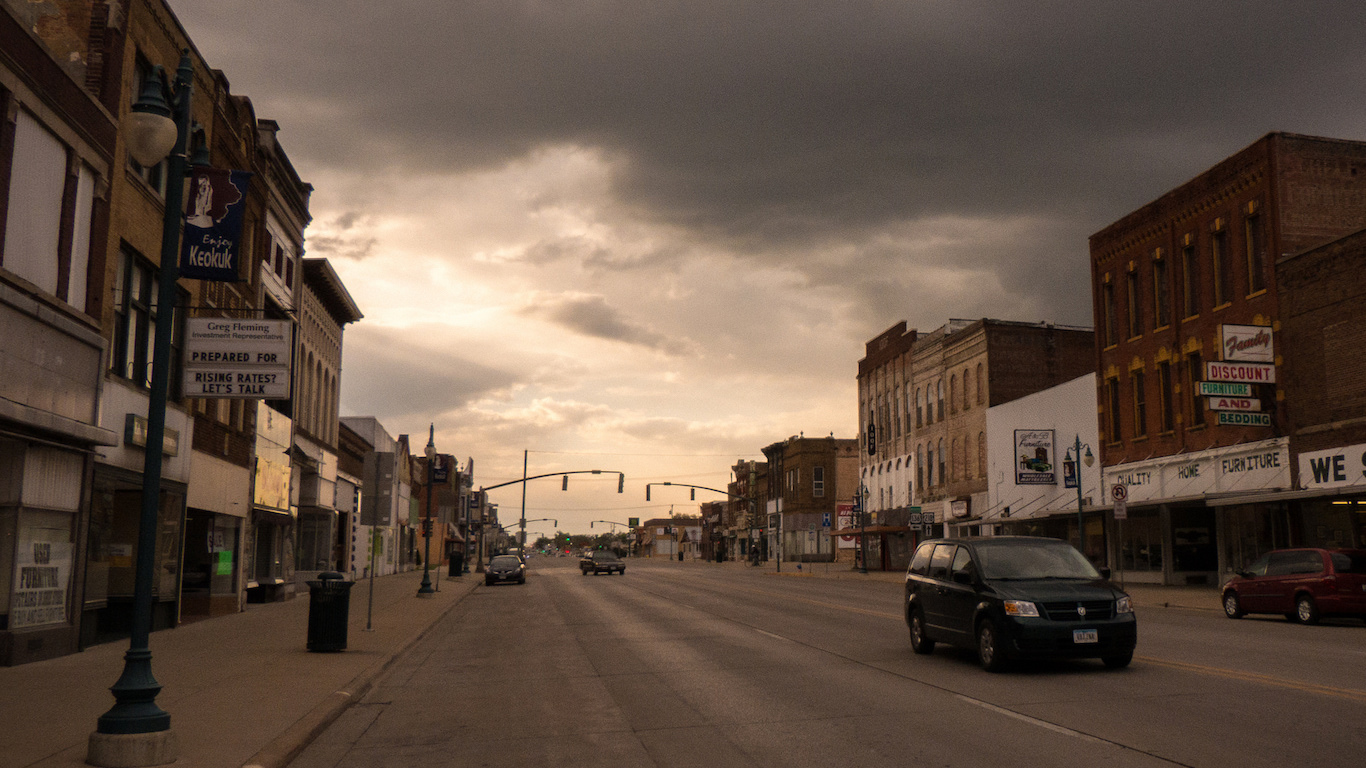
15. Keokuk, Iowa
> Town median household income: $33,608
> State median household income: $53,183
> Town poverty rate: 24.5%
> Town population: 10,705
Keokuk has the lowest median household income in Iowa. Low incomes and poverty rates tend to go hand in hand, and Keokuk’s 24.5% poverty rate is the highest of all towns of comparable size in the state. Home values in Keokuk also tend to be far lower than they are across the state. The typical area home is worth only $66,000, close to half of the $129,200 median home value across Iowa.
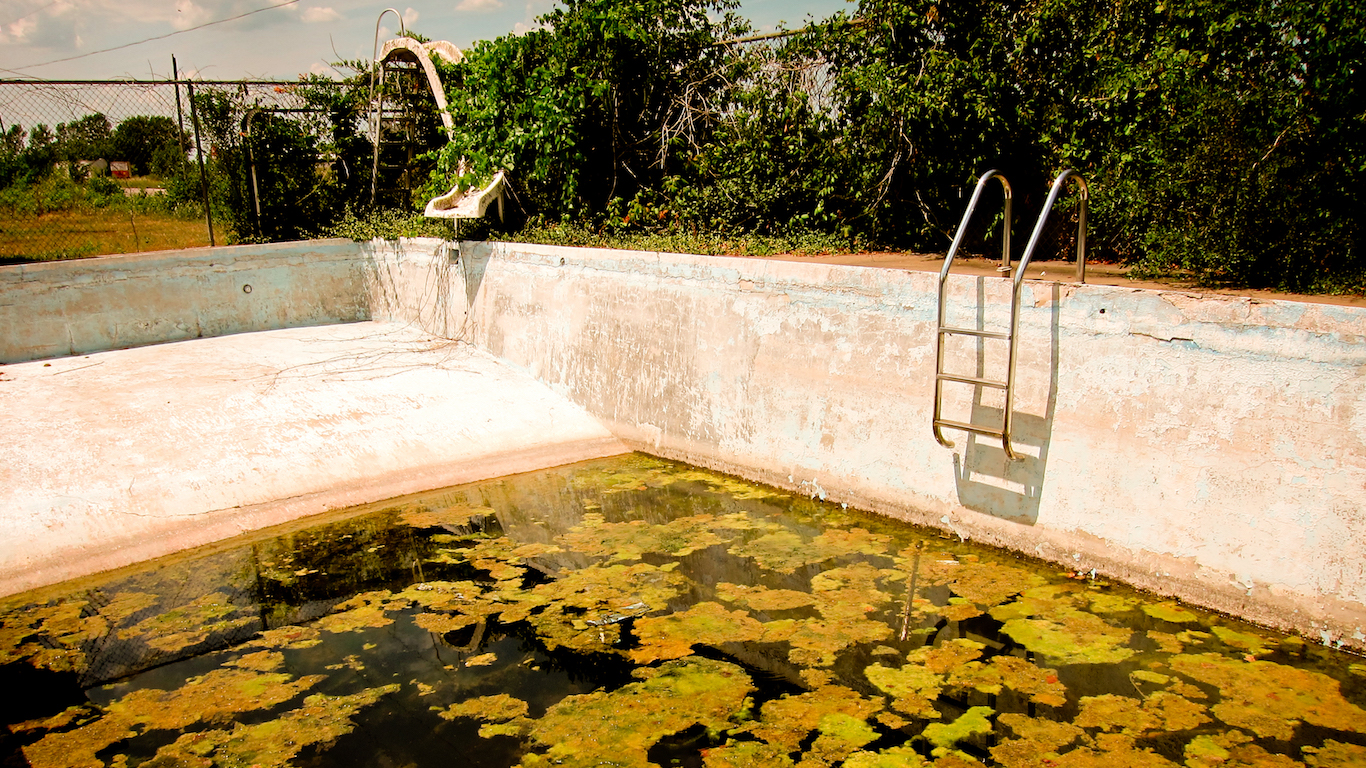
16. Fort Scott, Kansas
> Town median household income: $31,592
> State median household income: $52,205
> Town poverty rate: 21.7%
> Town population: 7,893
Home values typically reflect the relative wealth of a region’s population, particularly in smaller towns. With a population of less than 8,000, the typical home is worth In Fort Scott, the poorest town in Kansas, is worth just $67,200. In contrast, the state’s median home value is $132,000, and the national median home value is $178,600.
[in-text-ad]
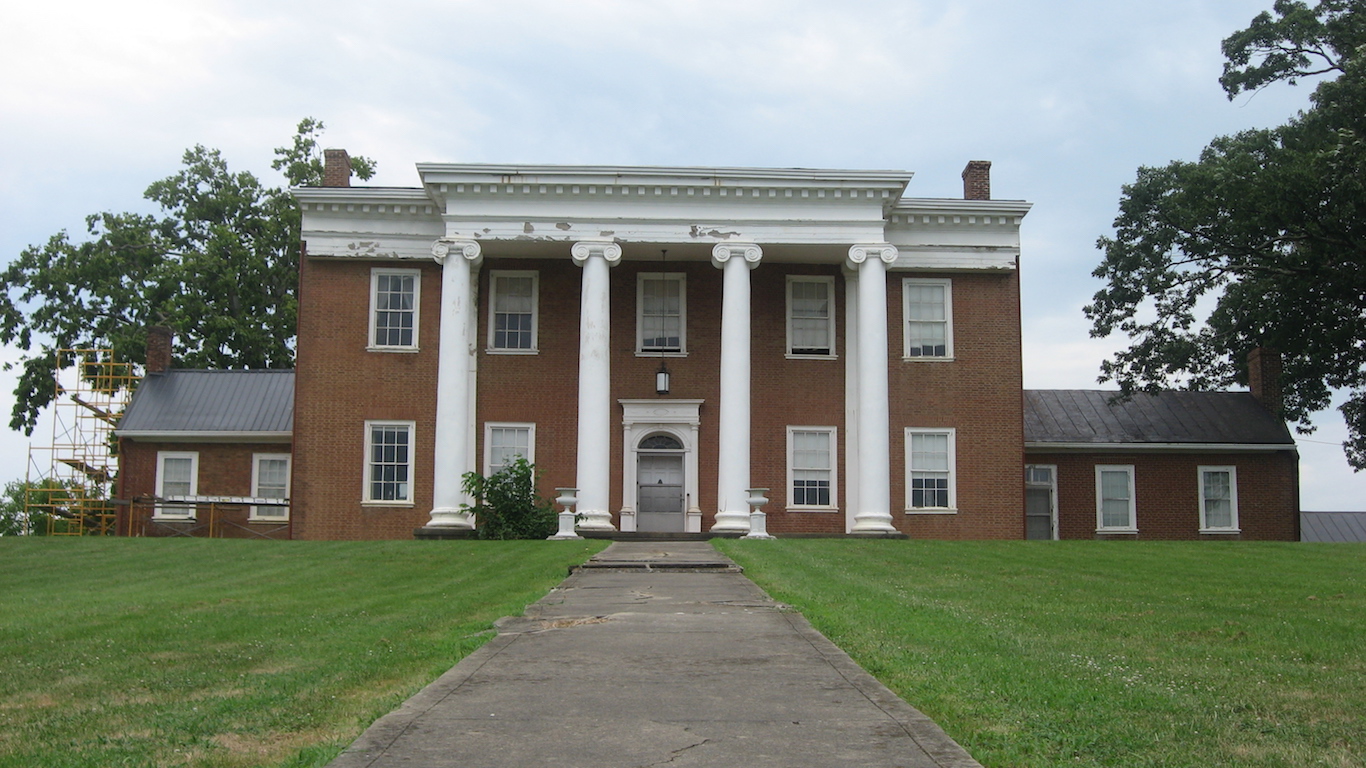
17. Harrodsburg, Kentucky
> Town median household income: $30,240
> State median household income: $43,740
> Town poverty rate: 28.9%
> Town population: 8,380
Some 17.3% of Kentucky residents rely on government assistance in the form of food stamps, one of the highest recipiency rates of all states. In Harrodsburg, the poorest town in the state, more than one in every five people receive food stamps. Like many other towns on this list, adults in Harrodsburg are less likely to have completed high school or get a college education than adults across the state as a whole.
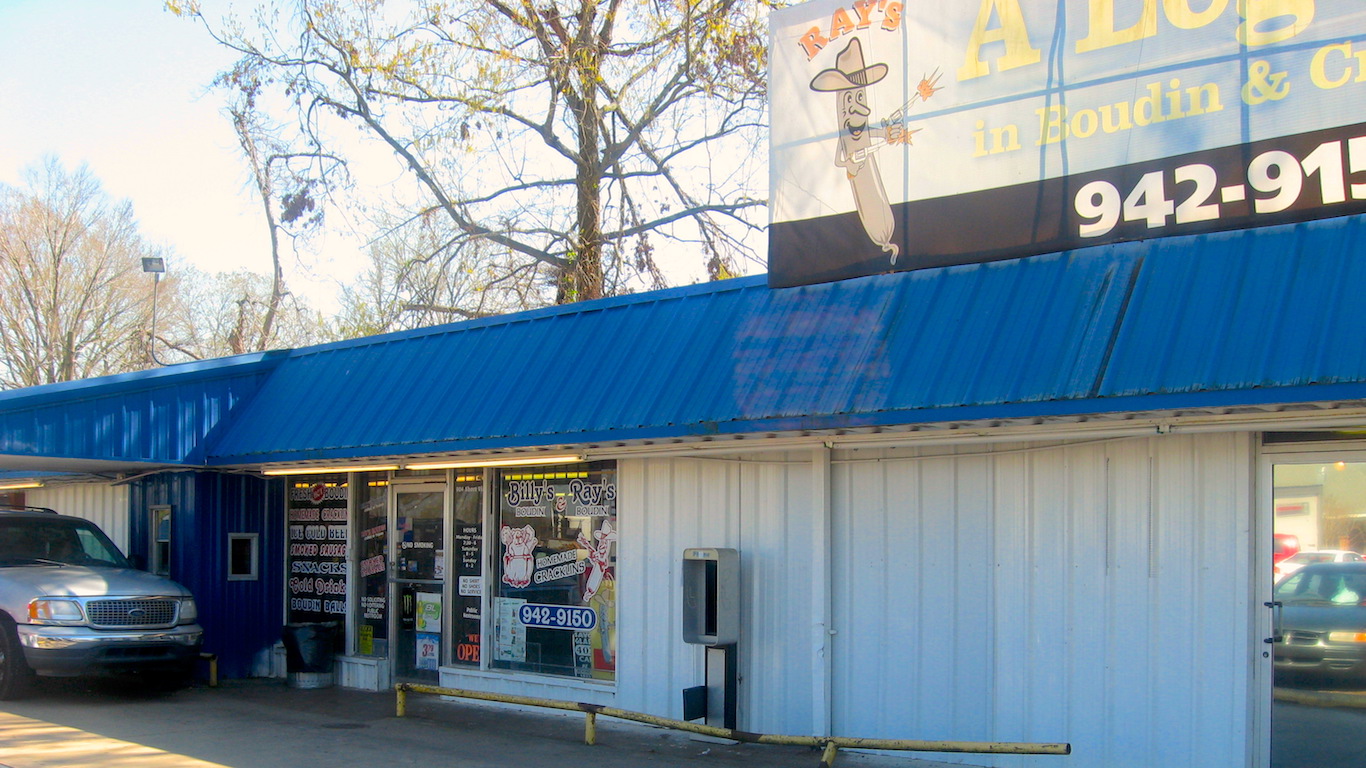
18. Opelousas, Louisiana
> Town median household income: $20,434
> State median household income: $45,047
> Town poverty rate: 41.9%
> Town population: 16,638
Opelousas is the poorest town in Louisiana and one of the poorest nationwide. Approximately 42% of the area’s 16,638 residents live below the poverty line, more than double the state’s poverty rate and nearly three times the national poverty rate of 15.5%. As might be expected, a large share of Opelousas’ households receive government aid. Nearly one-third the town’s population received in the past year SNAP benefits — formerly food stamps — compared to about 16% of state residents.
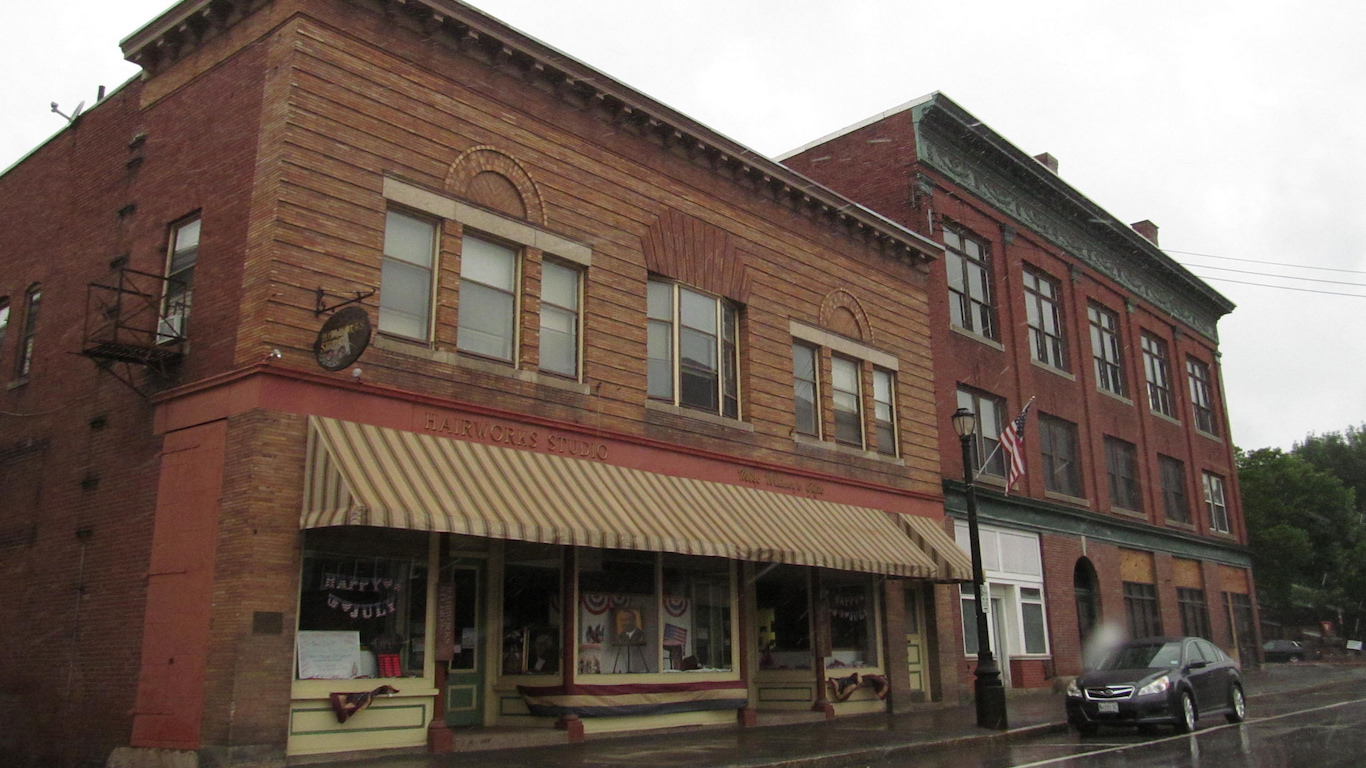
19. Houlton, Maine
> Town median household income: $32,131
> State median household income: $49,331
> Town poverty rate: 20.4%
> Town population: 4,778
Situated along the U.S.-Canada border and the northernmost tip of Interstate 95, Houlton is the poorest town in Maine. The typical Houlton household earns just $32,131 a year, far less than both the statewide median annual household income of $49,331 and the national median of $53,889. Earning potential in the area is likely suppressed by a low college attainment rate. Just 17.4% of the town’s adults have a bachelor’s degree, a smaller share than the statewide college attainment rate of 29.0%.
[in-text-ad-2]
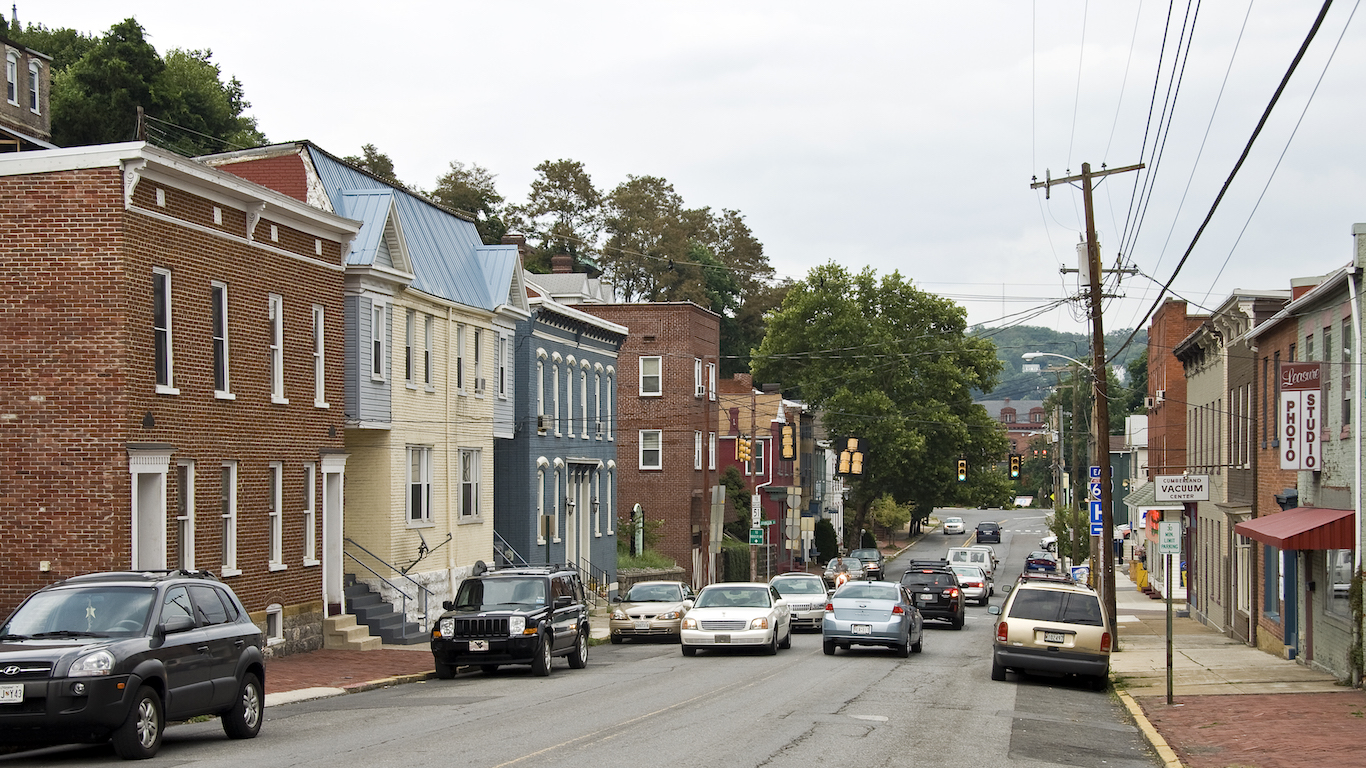
20. Cumberland, Maryland
> Town median household income: $30,275
> State median household income: $74,551
> Town poverty rate: 25.1%
> Town population: 20,449
In Cumberland, the poorest town in Maryland, about one in four residents live in poverty, more than double the 10% statewide poverty rate. With such pervasive financial hardship, a much larger than average share of residents rely on government assistance to meet their basic needs. Some 28.7% of town residents receive food stamps, well more than double the statewide 10.9% recipiency rate.

21. North Adams, Massachusetts
> Town median household income: $38,490
> State median household income: $68,563
> Town poverty rate: 18.5%
> Town population: 13,459
Massachusetts is, on the whole, one of the more affluent states in the country, with a median household income of $68,563 annually.And while the typical household in North Adams, the state’s poorest town, earns far less, at $38,490 a year, it still follows the general rule that the poorest town in a wealthy state still tends to fare better than those in poor states. North Adams’ poverty rate, while at 18.5% still above the national 15.5% rate, does not come close to the poverty rates in excess of 40% seen in many of the towns on this list.
[in-text-ad]
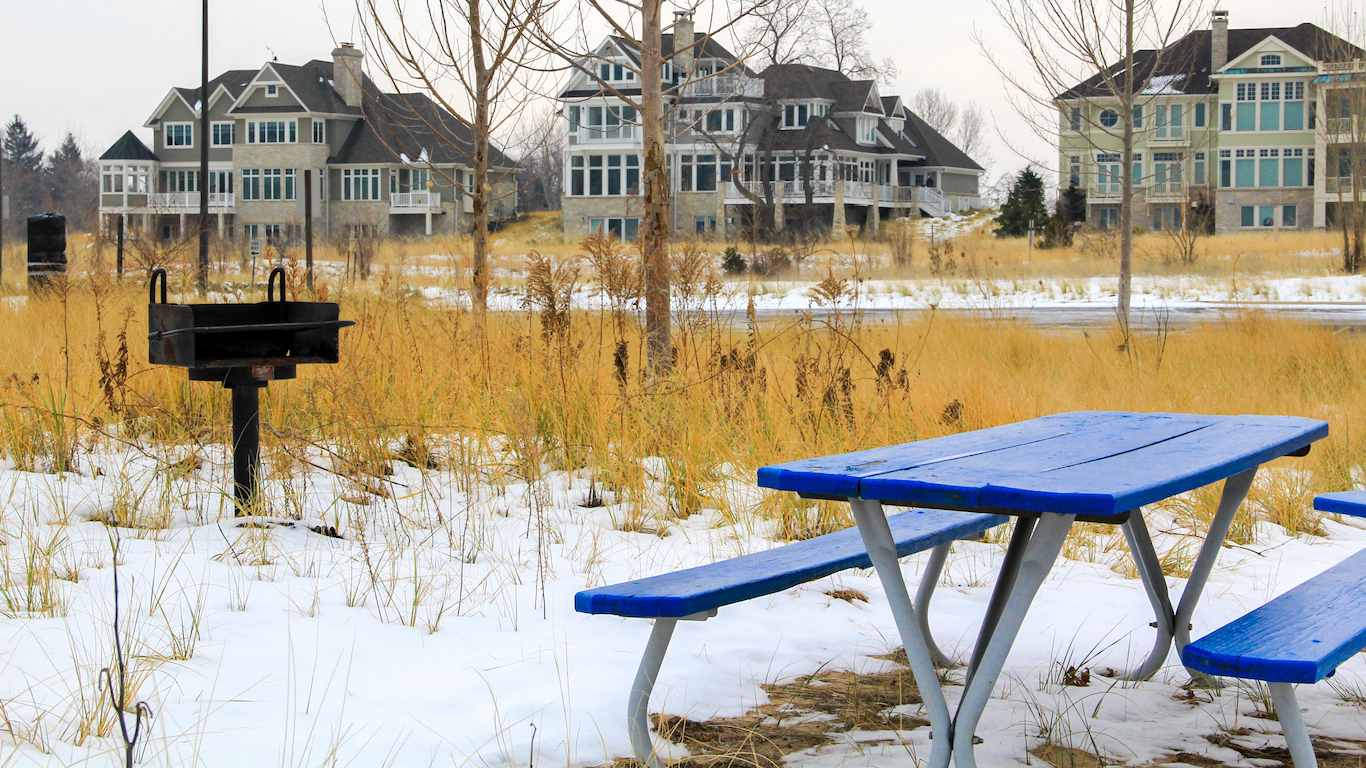
22. Benton Harbor, Michigan
> Town median household income: $18,085
> State median household income: $49,576
> Town poverty rate: 50.3%
> Town population: 10,014
While Benton Harbor was once a major manufacturing center with a population of more than 20,000 in the 1960s, today the lakeside city is the poorest town in Michigan and has half the population it had five decades ago. The typical Benton Harbor household earns just $18,085 a year, less than half the state median annual household income of $49,576. Nearly 60% of the Benton Harbor population depends on the SNAP welfare program, the largest share of any town on this list.
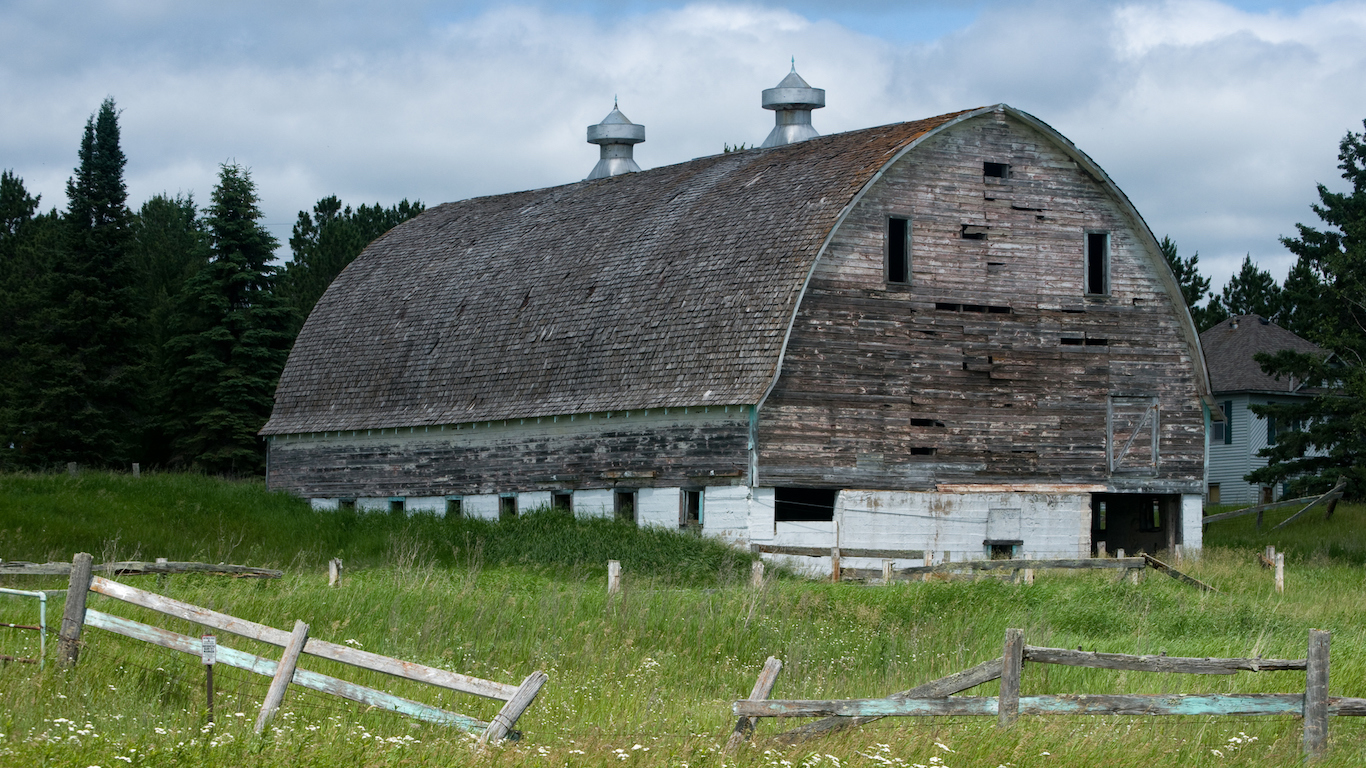
23. Brainerd, Minnesota
> Town median household income: $30,975
> State median household income: $61,492
> Town poverty rate: 21.8%
> Town population: 13,462
The typical household in Brainerd earns only $30,975 a year, roughly half the $61,492 median annual income across Minnesota. In most cities on this list, educational attainment rates tend to lag behind comparable national rates. However, in Brainerd, 91.6% of adults have at least a high school diploma, a larger share than the 86.7% of American adults who do. Still, the highest paying jobs are often only available to those with a college education, and only 17.5% of adults in Brainerd have a bachelor’s degree, far less than the 29.8% of American adults and 33.7% of adults in Minnesota who do.
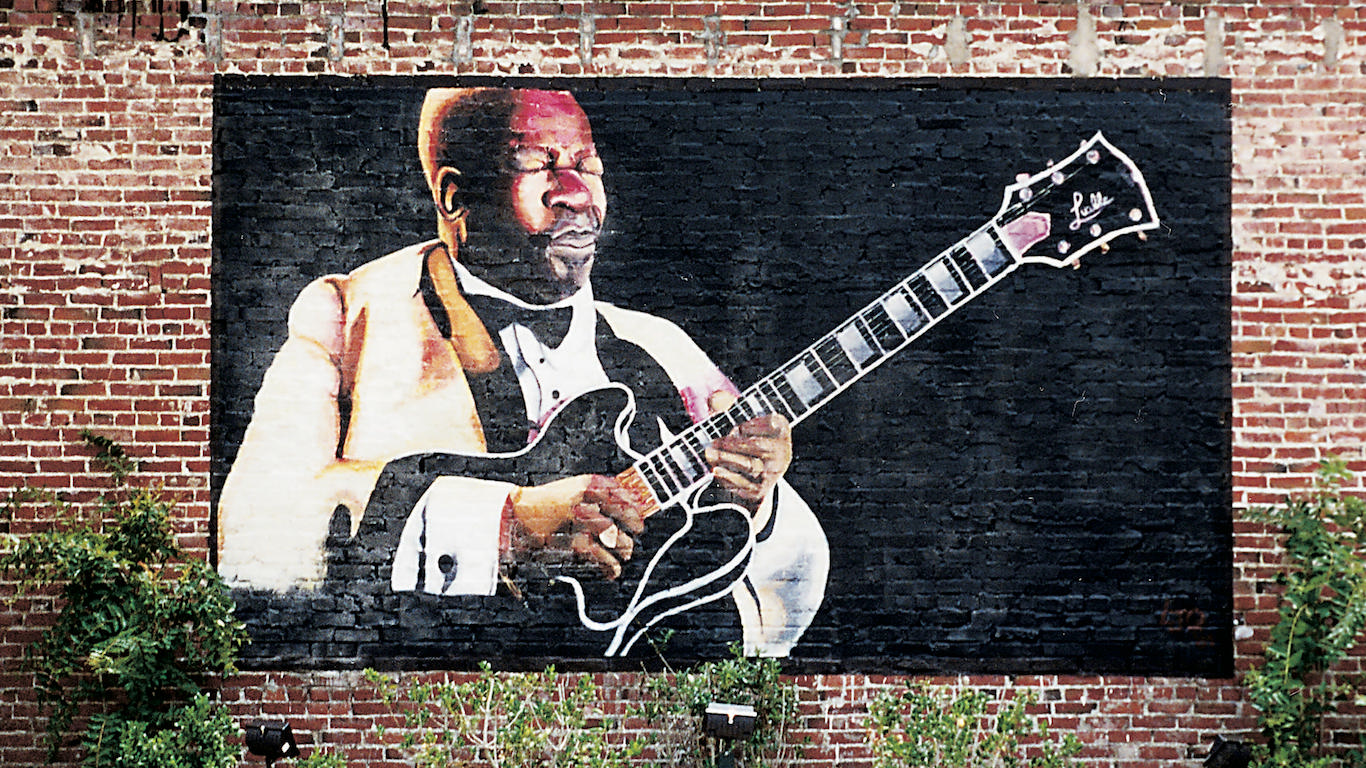
24. Indianola, Mississippi
> Town median household income: $26,544
> State median household income: $39,665
> Town poverty rate: 33.2%
> Town population: 10,281
The only state with a median household income of less than $40,000 annually, Mississippi is the poorest state in the country. There is a relatively small income gap between Mississippi’s general population and those who live Indianola, the poorest town in the state. Indianola’s median household income is just $13,000 below that of the state, while in many poor towns the difference exceeds $30,000.
[in-text-ad-2]
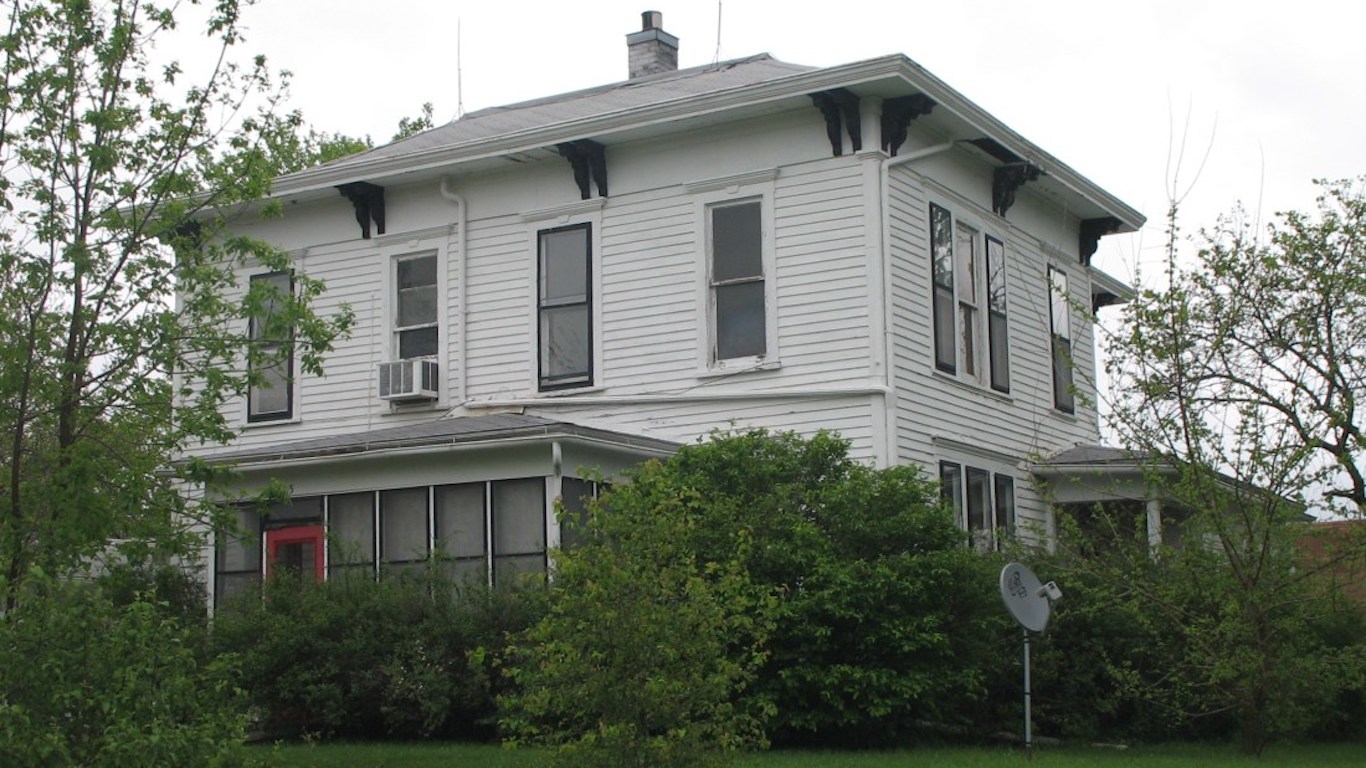
25. Maryville, Missouri
> Town median household income: $26,889
> State median household income: $48,173
> Town poverty rate: 38.1%
> Town population: 11,997
High educational attainment within a given population often translates to higher incomes. Maryville, however, is an exception to the rule. While the town’s median income of $26,889 a year is the lowest Missouri, an estimated 28.7% of area adults have at least a bachelor’s degree — a larger share than the 27.1% of adults across Missouri with a four-year college degree. In addition to having the lowest median income, 38.1% of Maryville residents live in poverty, the highest poverty rate of any small town in Missouri.
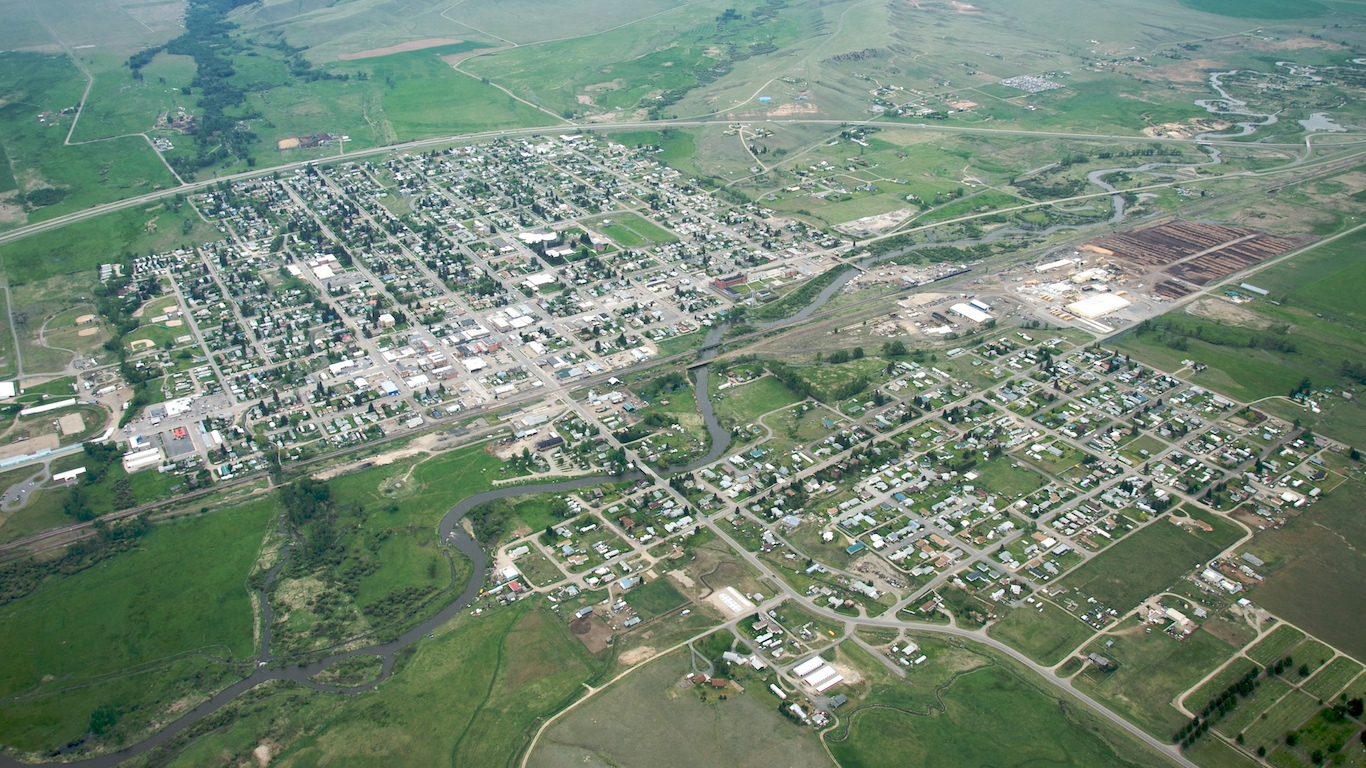
26. Deer Lodge, Montana
> Town median household income: $37,934
> State median household income: $47,169
> Town poverty rate: 16.0%
> Town population: 3,056
In Deer Lodge, Montana’s poorest town, the typical household earns only $37,934, less than any other town of comparable size in the state. While incomes are low in the town, income is relatively even distributed, and extremely low incomes are not much more common than across the country. Deer Lodge’s poverty rate of 16% is only slightly higher than the national rate of 15.5%.
[in-text-ad]
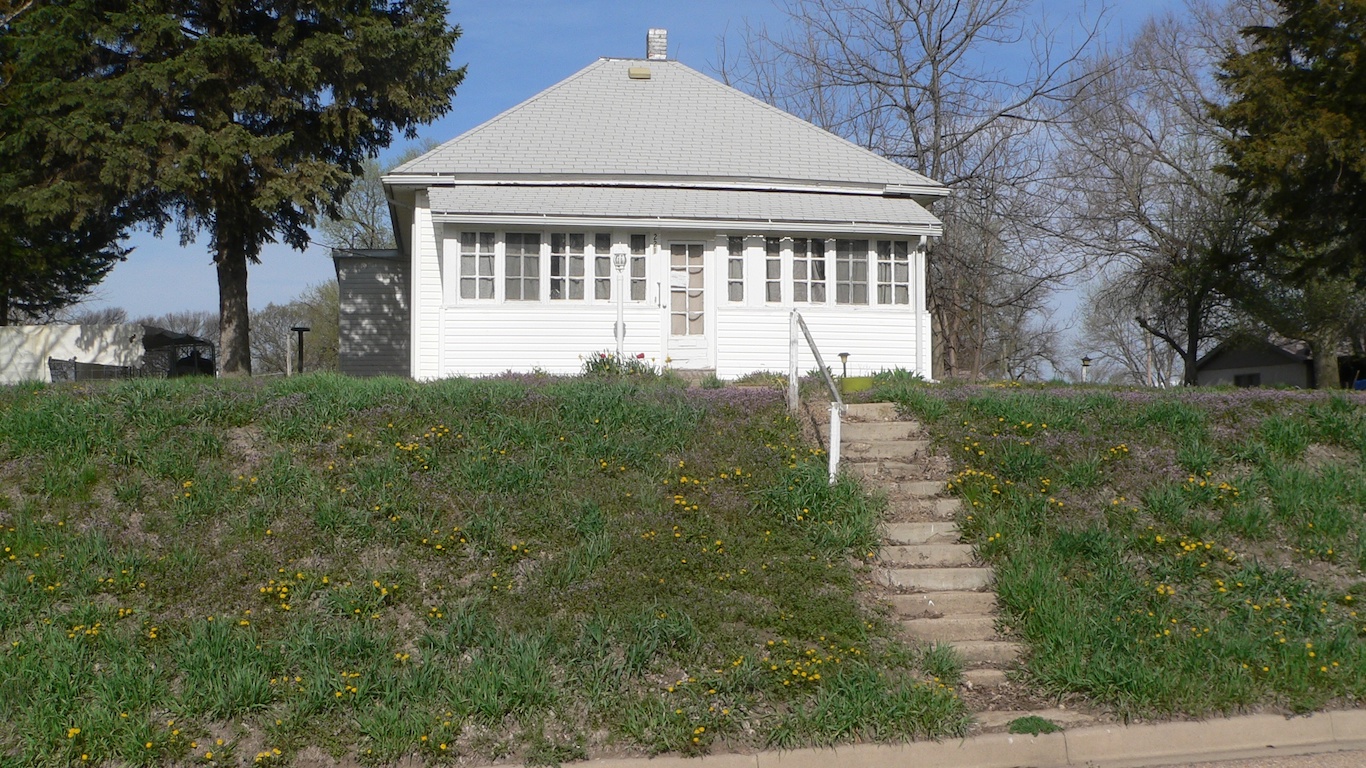
27. Red Cloud, Nebraska
> Town median household income: $32,917
> State median household income: $52,997
> Town poverty rate: 22.1%
> Town population: 1,075
The typical Red Cloud household earns only $32,917 a year, about $20,000 less than the statewide median income. Red Cloud’s poverty rate, while not as high as in many poor towns on this list, is still 22.1% — well above the 15.5% national poverty rate and nearly twice the statewide rate.
One of the smallest poor towns on this list, Red Cloud has a population of just 1,075 people.
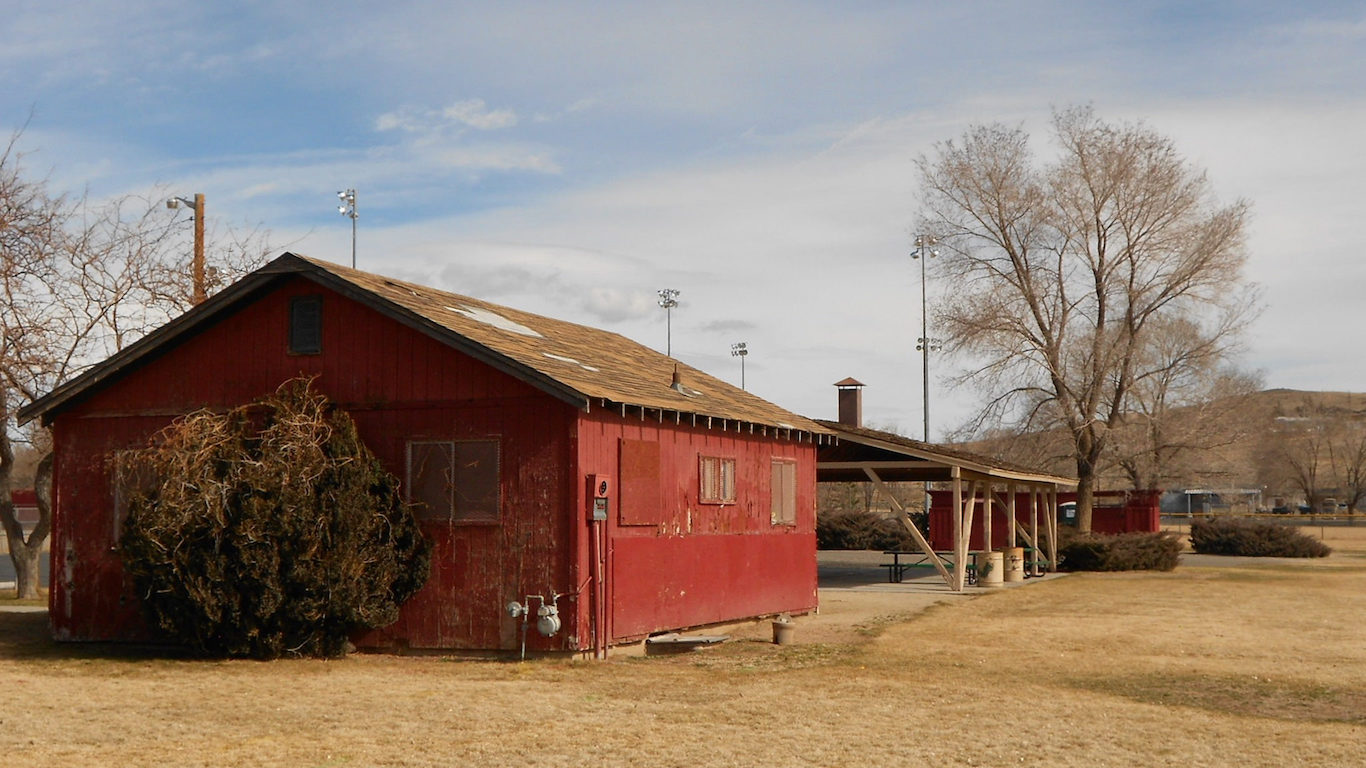
28. Sun Valley, Nevada
> Town median household income: $44,013
> State median household income: $51,847
> Town poverty rate: 19.6%
> Town population: 19,663
The typical household in Sun Valley, Nevada’s poorest town, earns $44,013 a year, less than the state’s median household income of $51,847. The wealthiest town in the state, Spanish Springs, is located just a few miles down State Route 445. The typical Spanish Springs household earns $78,604 a year, roughly $35,000 more than in Sun Valley. Still, the income gap between Nevada’s richest and poorest towns is far less than the $90,000 average difference across all 50 states.
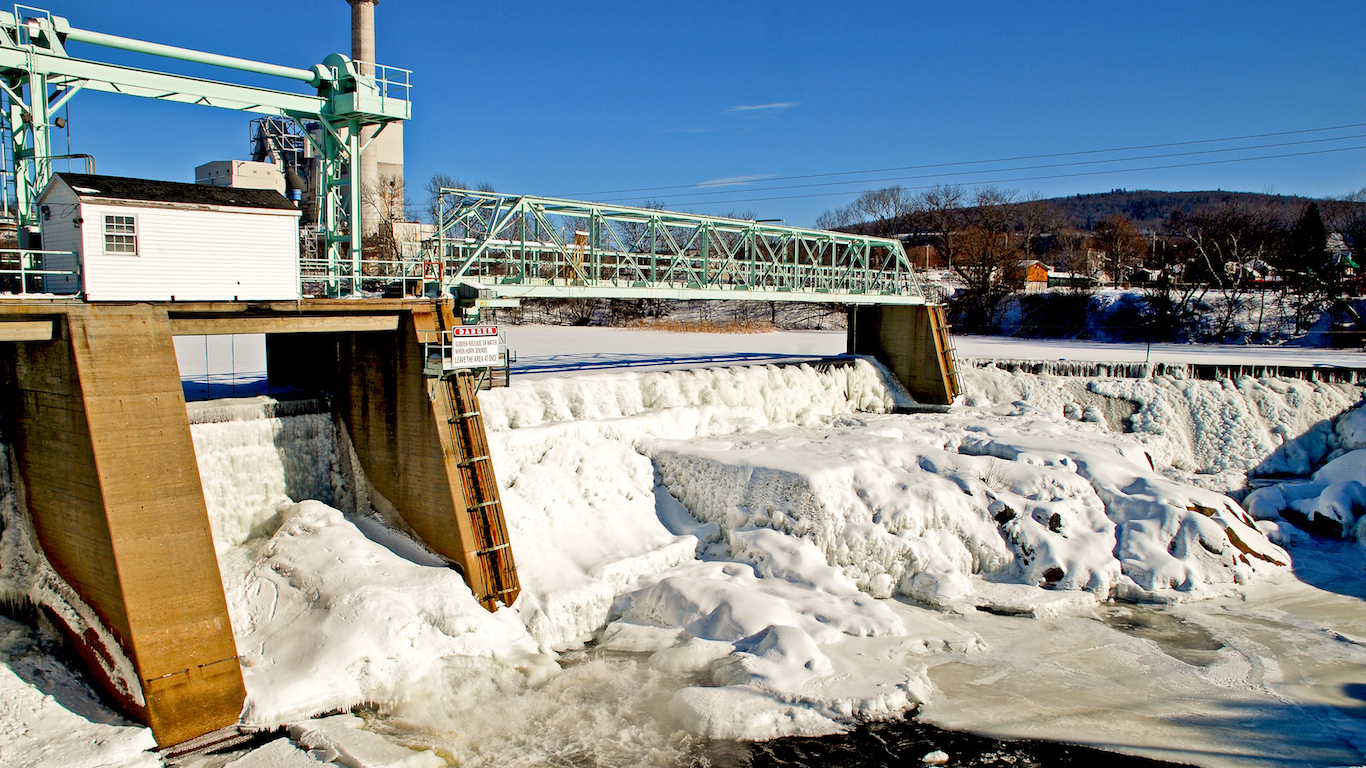
29. Berlin, New Hampshire
> Town median household income: $35,523
> State median household income: $66,779
> Town poverty rate: 20.3%
> Town population: 9,580
Educational attainment is often a strong indicator of regional affluence. Those with a college education, for example, are more likely to find stable employment and earn above poverty wages. In Berlin, New Hampshire’s poorest town, barely one in 10 adults have at least a bachelor’s degree, compared to more than one in three adults statewide.
[in-text-ad-2]
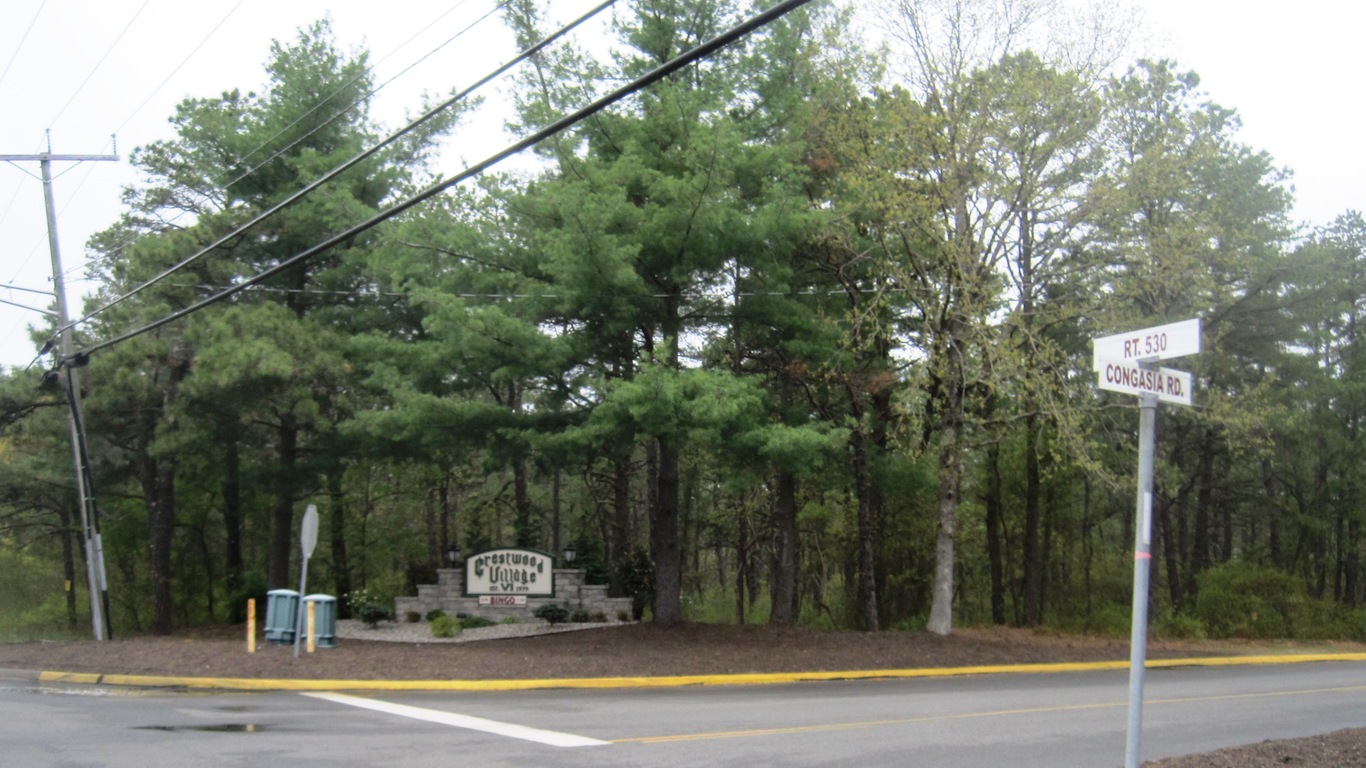
30. Crestwood Village, New Jersey
> Town median household income: $29,649
> State median household income: $72,093
> Town poverty rate: 10.4%
> Town population: 7,958
With a median household income of $72,093 a year, New Jersey is one of the wealthiest states in the country. Not all parts of the state are especially well off, however. The typical household in Crestwood Village earns only $29,649 a year — less than half the statewide median income. Low incomes are more common in areas with low educational attainment, and in Crestwood Village, only 12.2% of adults have at least a bachelor’s degree, about a third of the bachelor’s degree attainment rate statewide.
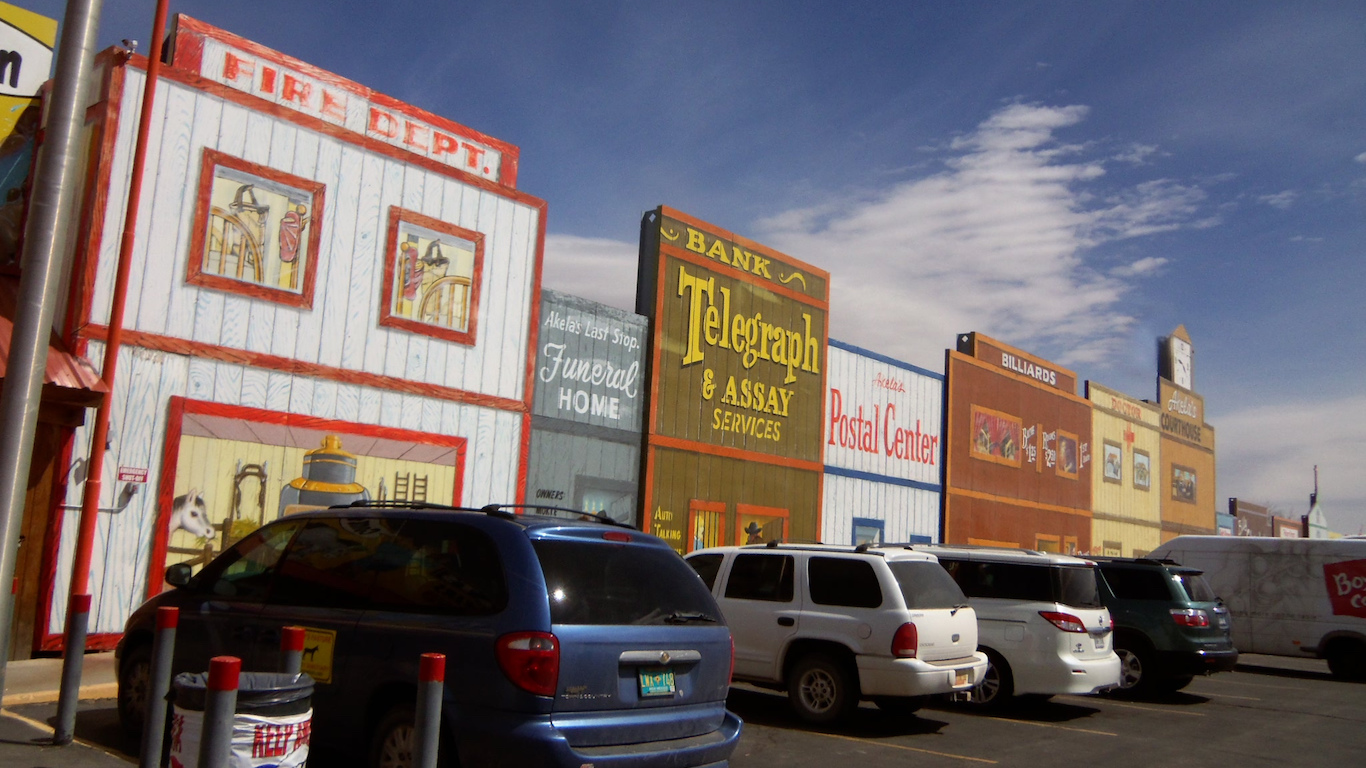
31. Deming, New Mexico
> Town median household income: $25,844
> State median household income: $44,963
> Town poverty rate: 33.1%
> Town population: 14,667
New Mexico is one of the poorest states in the country. The median household income in only two of the nine small towns in the state is as high as as the median income nationwide. And in the state’s poorest town, the median income is less than half that. The typical household in Deming, New Mexico’s poorest town, earns $25,844 a year, far less than both the median income of $44,963 statewide and $53,889 nationwide. Roughly one in three Deming residents live in poverty, more than twice the national poverty rate.
[in-text-ad]
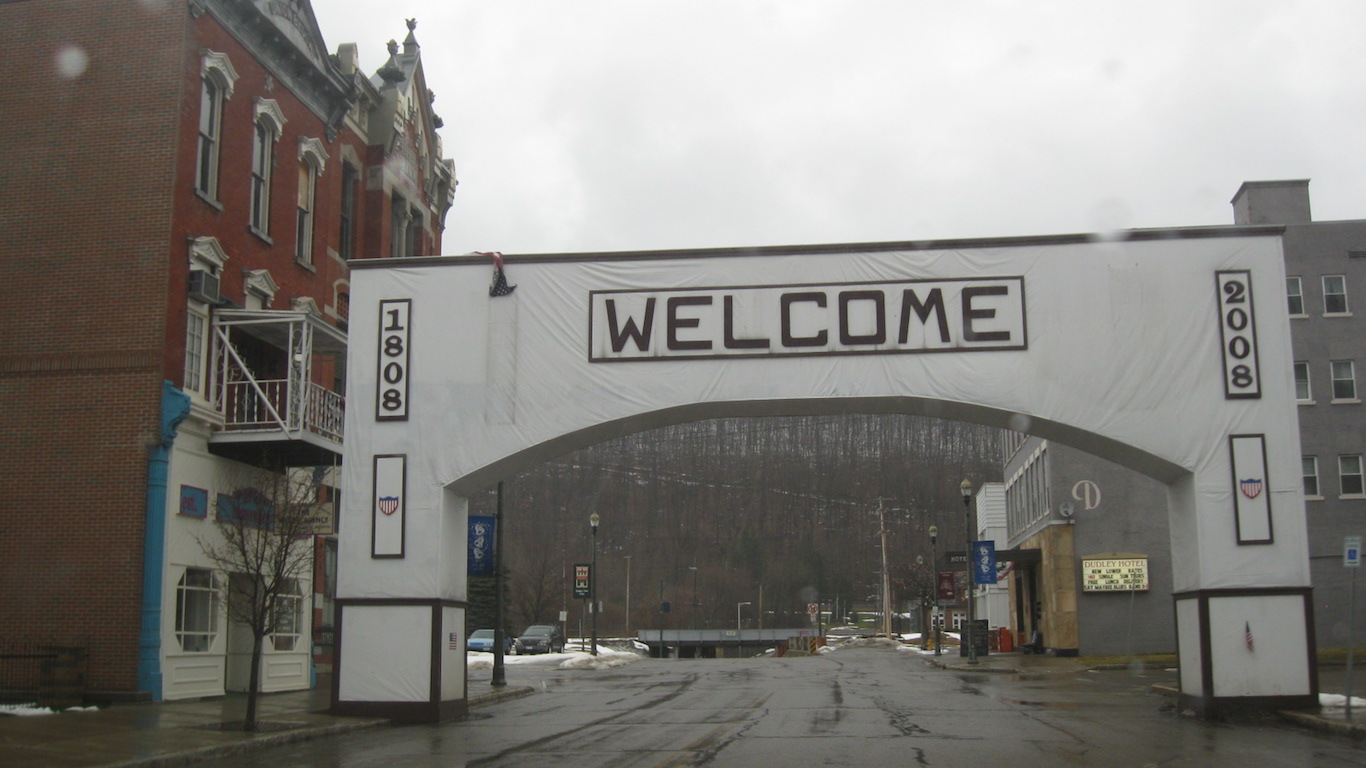
32. Salamanca, New York
> Town median household income: $30,557
> State median household income: $59,269
> Town poverty rate: 28.1%
> Town population: 5,686
Salamanca, located in far western New York near the state’s border with Pennsylvania, is the state’s poorest town. Real estate values often reflect the attractiveness of a region, economic conditions, and the ability of locals to afford homes. While as a state New York’s homes are among the most expensive in the country — with a median home value of $283,400 — the typical home in Salamanca is worth just $64,500. This disparity is reflected in other ways in the state. According to one measure of income distribution, New York has the highest income inequality in the country.
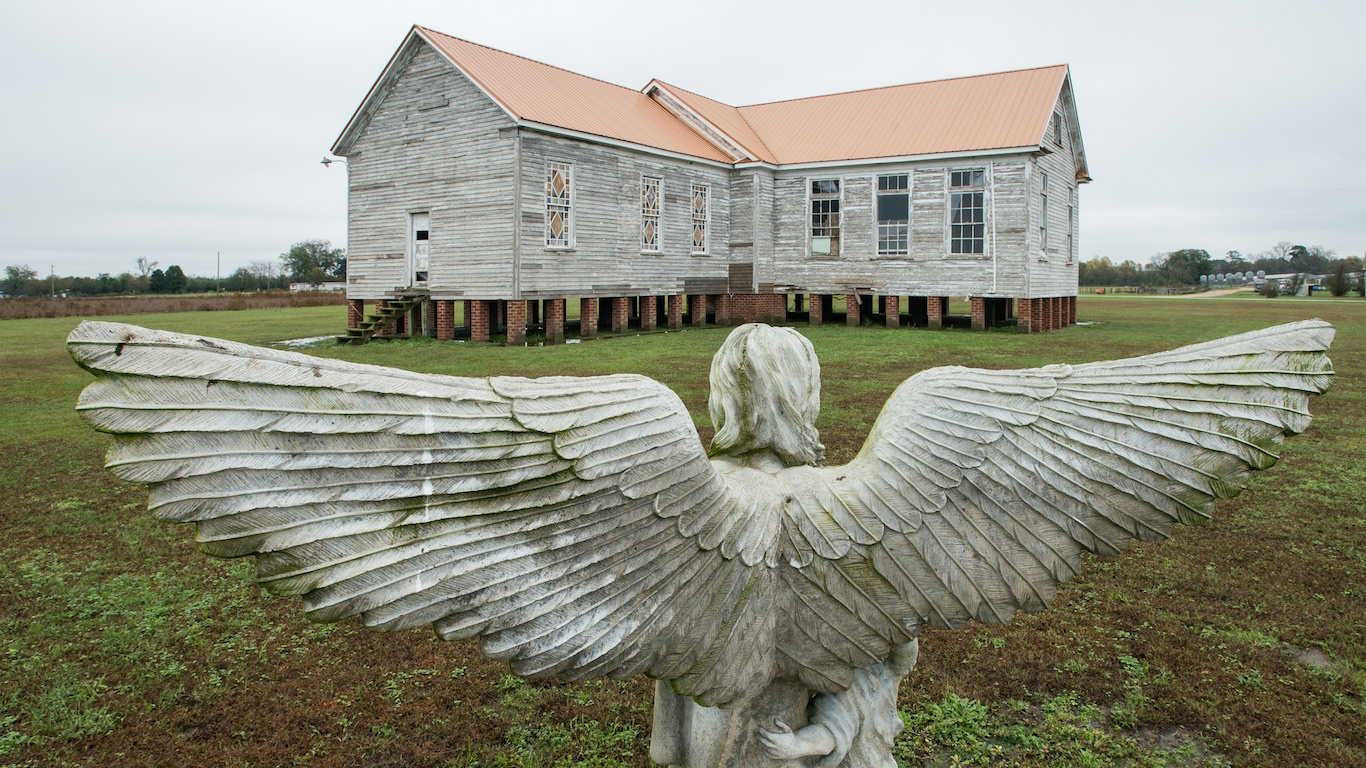
33. Mount Olive, North Carolina
> Town median household income: $25,838
> State median household income: $46,868
> Town poverty rate: 31.5%
> Town population: 4,756
Mount Olive has had a surge of Haitian immigration in recent years. While the Census counted no Haitians in the town in 2010, by 2012 Haitians were estimated to comprise nearly one-sixth of the population. Many of the new residents took low-paying jobs at the town’s meat processing plants. While Mount Olive has provided a living for thousands of Haitians seeking refuge from natural disaster, the influx of low-income workers may have lowered the area’s income. The median household income fell from $30,292 in 2010 to $25,838 today, now the lowest of any North Carolina small town.
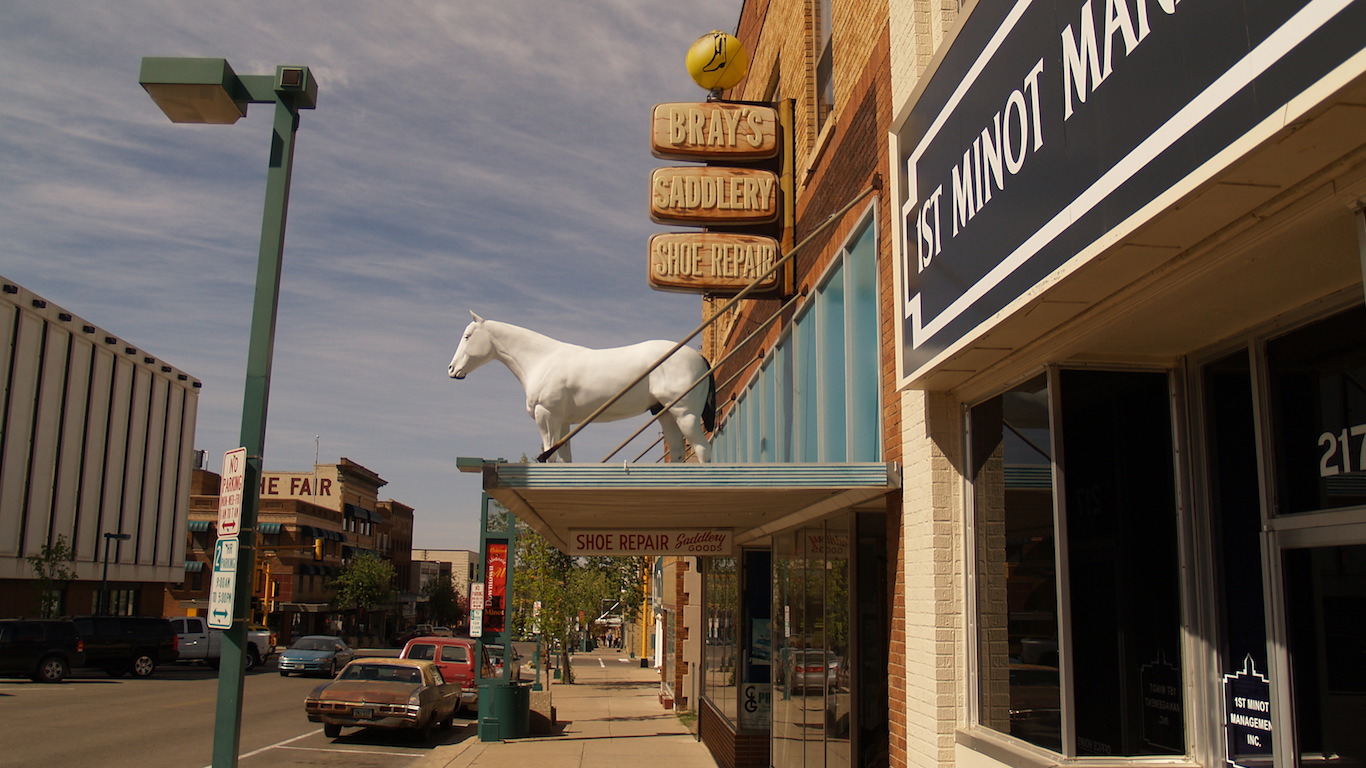
34. Minot, North Dakota
> Town median household income: $39,639
> State median household income: $57,181
> Town poverty rate: 9.0%
> Town population: 5,890
Minot is an Air Force Base community located about an hour south of the Canadian border in North Dakota. Because its economy is based largely on the military, Minot does not closely resemble many other towns on this list.
Though the median income in Minot is the lowest of any town of comparable size in the state, the typical home is worth over a quarter million dollars, the most of any town of comparable size in the state. The incongruity is likely the result of government subsidized housing on the base. In addition, 9% of area residents live in poverty, a smaller share than both the 11.5% statewide and 15.5% national poverty rates.
[in-text-ad-2]
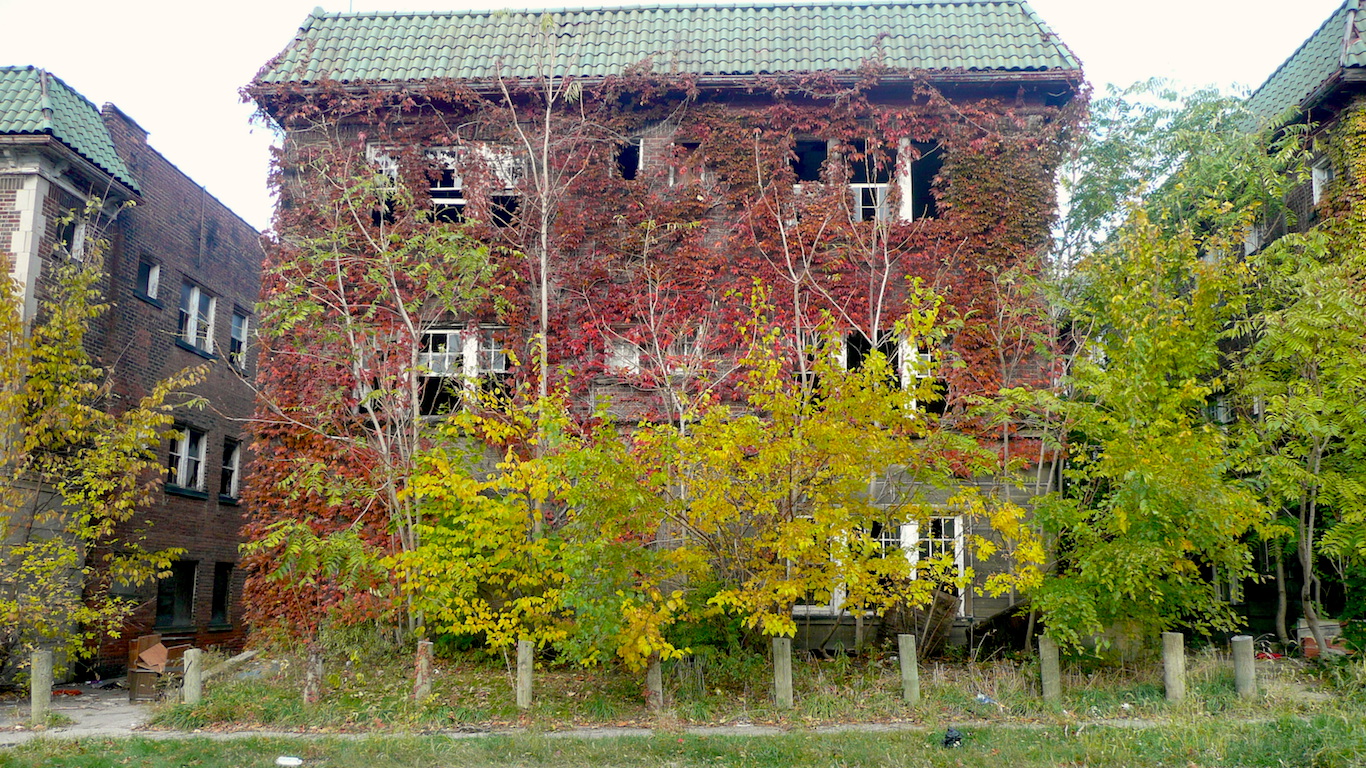
35. East Cleveland, Ohio
> Town median household income: $19,592
> State median household income: $49,429
> Town poverty rate: 42.6%
> Town population: 17,519
Cleveland’s first suburb, East Cleveland, is emblematic of the urban decay and economic decline that has distressed the metro area in the past few decades. Because many of the wealthiest residents have fled East Cleveland, the area’s median income has declined. The outbound migration has also created a major vacancy problem. The population has fallen from roughly 40,000 in 1950 to just 17,500 as of 2015, and today minorities comprise more than 90% of the population. The typical East Cleveland household earns just $19,592 annually, less than half the $49,249 statewide median income.
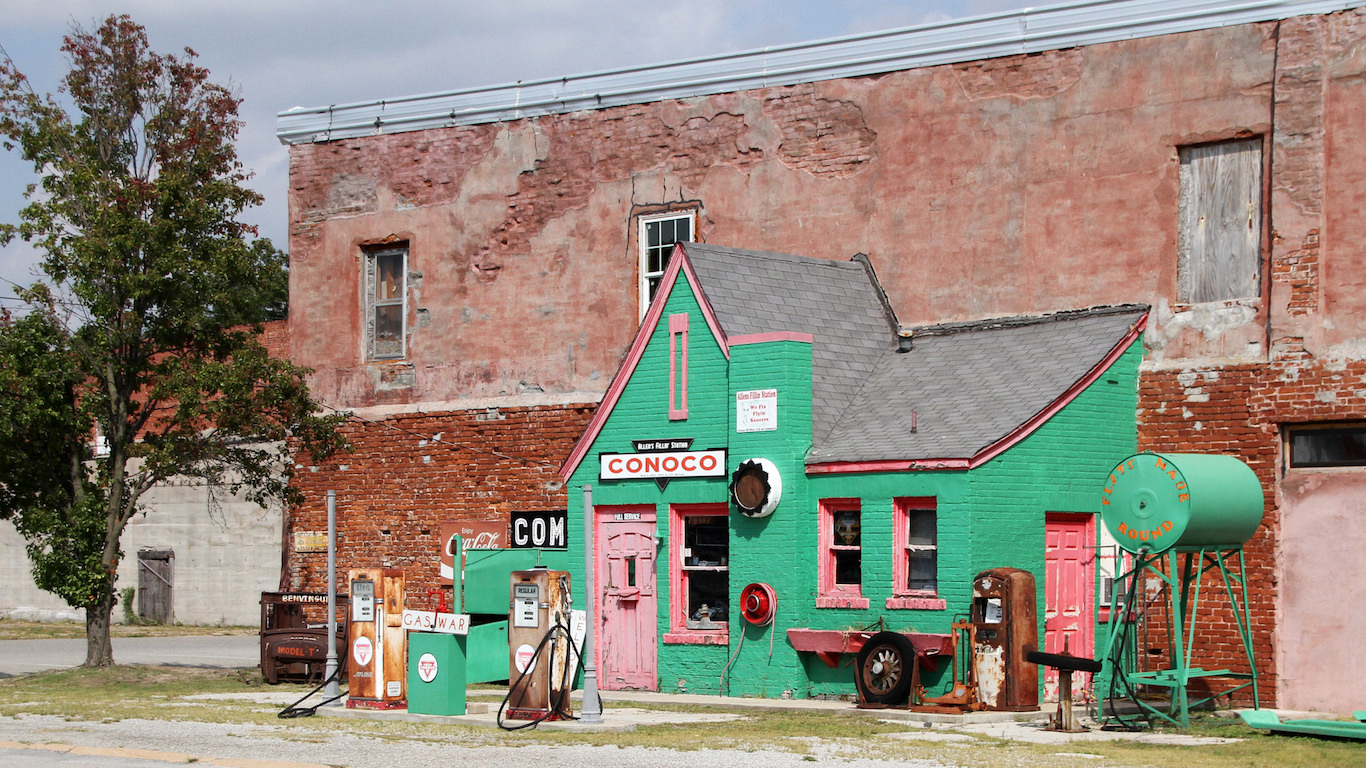
36. Commerce, Oklahoma
> Town median household income: $26,594
> State median household income: $46,879
> Town poverty rate: 34.8%
> Town population: 2,475
With a median household income of only $46,879 a year, Oklahoma is one of the poorest states in the country. Economic conditions in Commerce, located in the northeast corner of the state just outside the Kansas and Missouri state borders, are far worse. The typical Commerce household earns only $26,594 a year, and more than one third of town residents live in poverty. Without high-paying jobs, a larger than typical share of area residents depend on financial assistance from the government. Some 31.5% of Commerce residents receive food stamps — more than double the statewide 13.9% recipiency rate.
[in-text-ad]
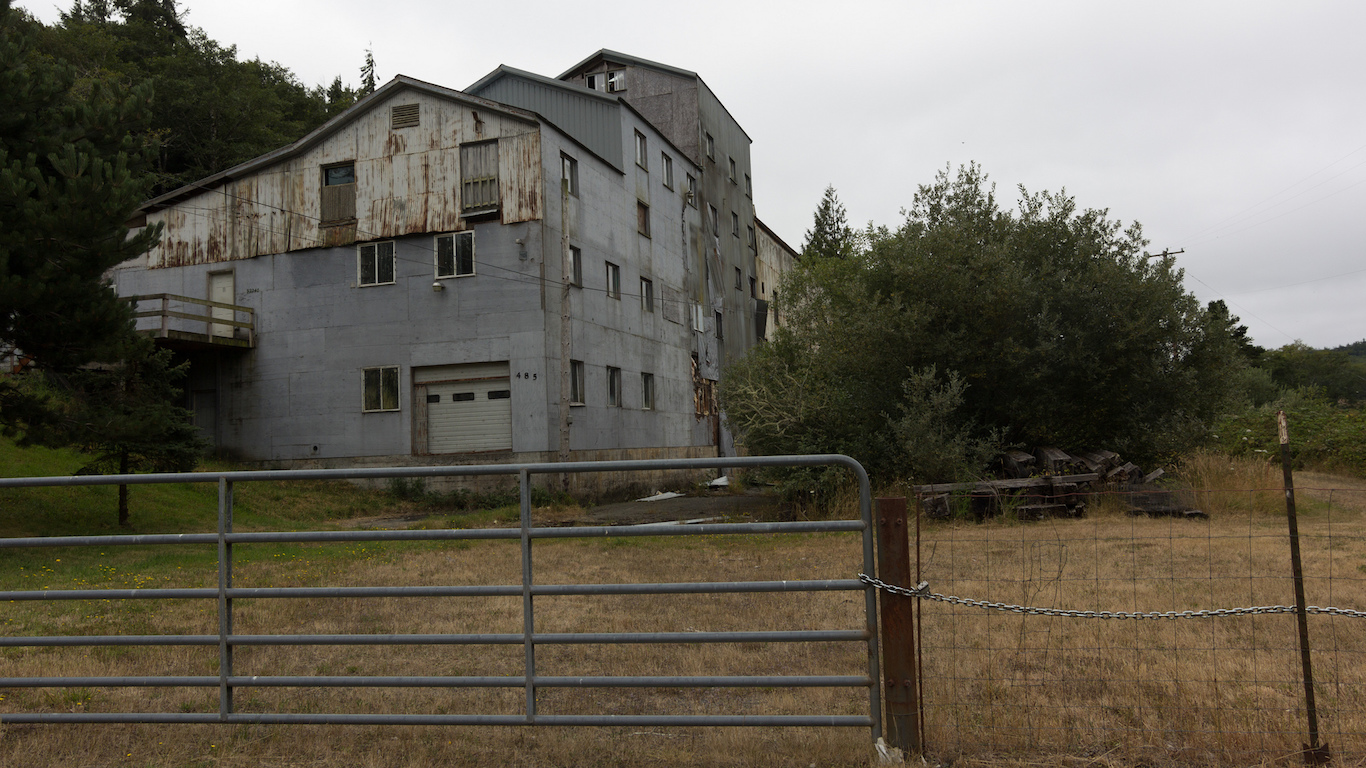
37. Coquille, Oregon
> Town median household income: $32,581
> State median household income: $51,243
> Town poverty rate: 15.1%
> Town population: 3,846
Oregon has the highest Supplemental Nutrition Assistance Program recipiency rate of any state, at about 19% of the population. In Coquille, Oregon’s poorest town, nearly 40% of the population relies on SNAP benefits — also known as food stamps. However, while many Coquille residents qualify for food stamps, a large share of those receiving food stamps earn incomes above the poverty line. Coquille’s poverty rate is just 15.1%, slightly below the 16.5% state figure.
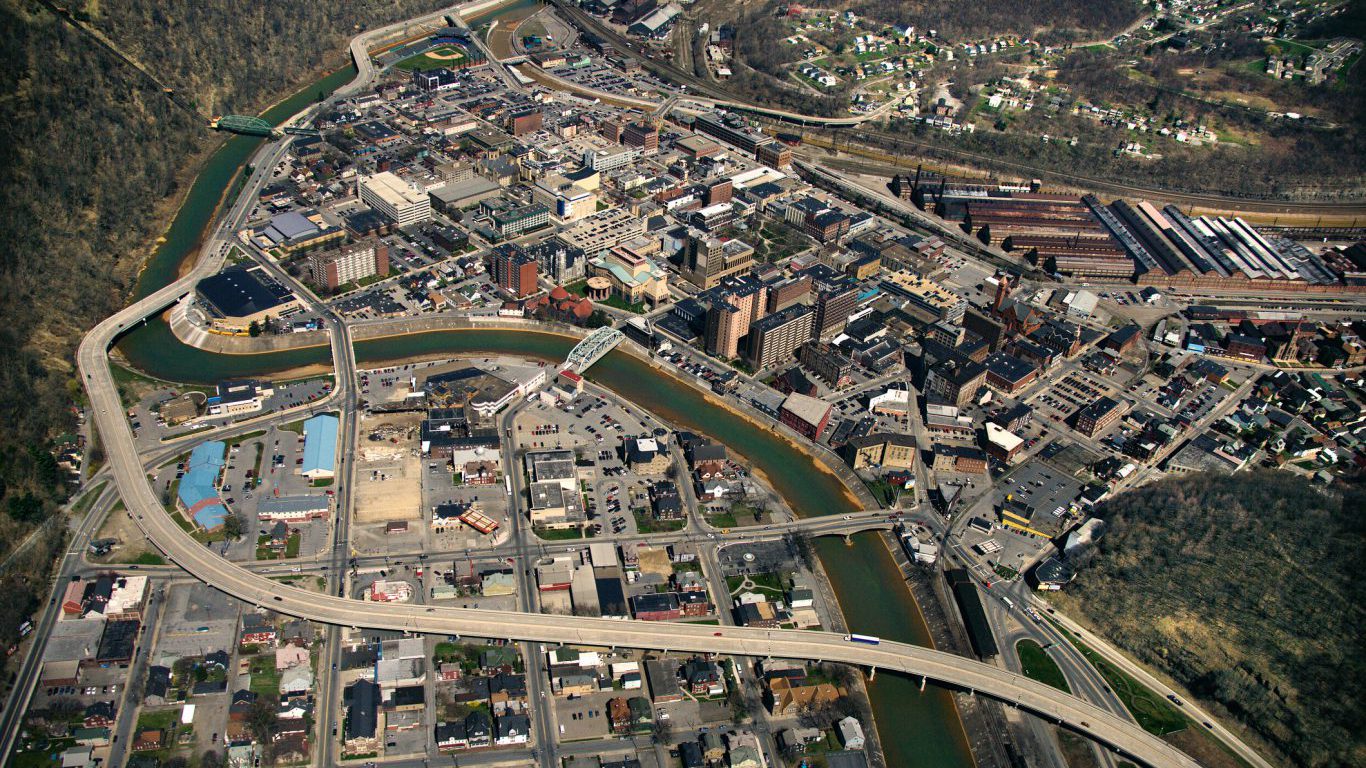
38. Johnstown, Pennsylvania
> Town median household income: $24,415
> State median household income: $53,599
> Town poverty rate: 35.1%
> Town population: 20,369
More than one in three people in Johnstown, Pennsylvania live in poverty — the largest share of any town of comparable size in the state. Johnstown has suffered considerably from the decline of its once robust steel industry
Situated about 70 miles east of Pittsburgh, Johnstown is known for a 1889 flood that killed over 2,000 people. Johnstown has been devastated by two floods since. While the town has embraced the floods as a part of its identity, some speculate flooding has contributed to significant population declines since the 1970s.
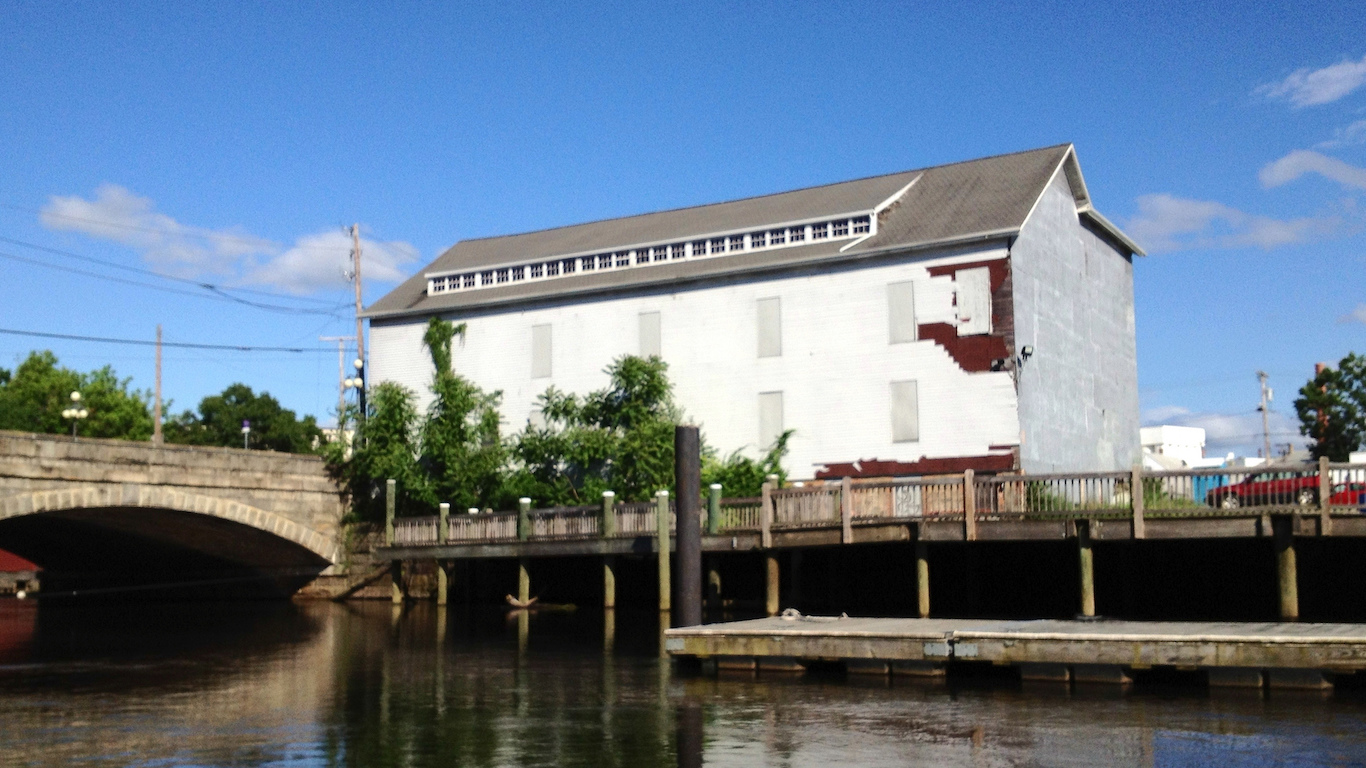
39. Central Falls, Rhode Island
> Town median household income: $29,108
> State median household income: $56,852
> Town poverty rate: 33.2%
> Town population: 19,378
Central Falls is the poorest town in Rhode Island. The typical household in the town earns less than $30,000 each year, compared to the national median household income of $53,889. About one in three residents live below the poverty line, more than double the national poverty rate. In 2011, the city of about 19,000 residents declared bankruptcy, from which it emerged the following year.
[in-text-ad-2]
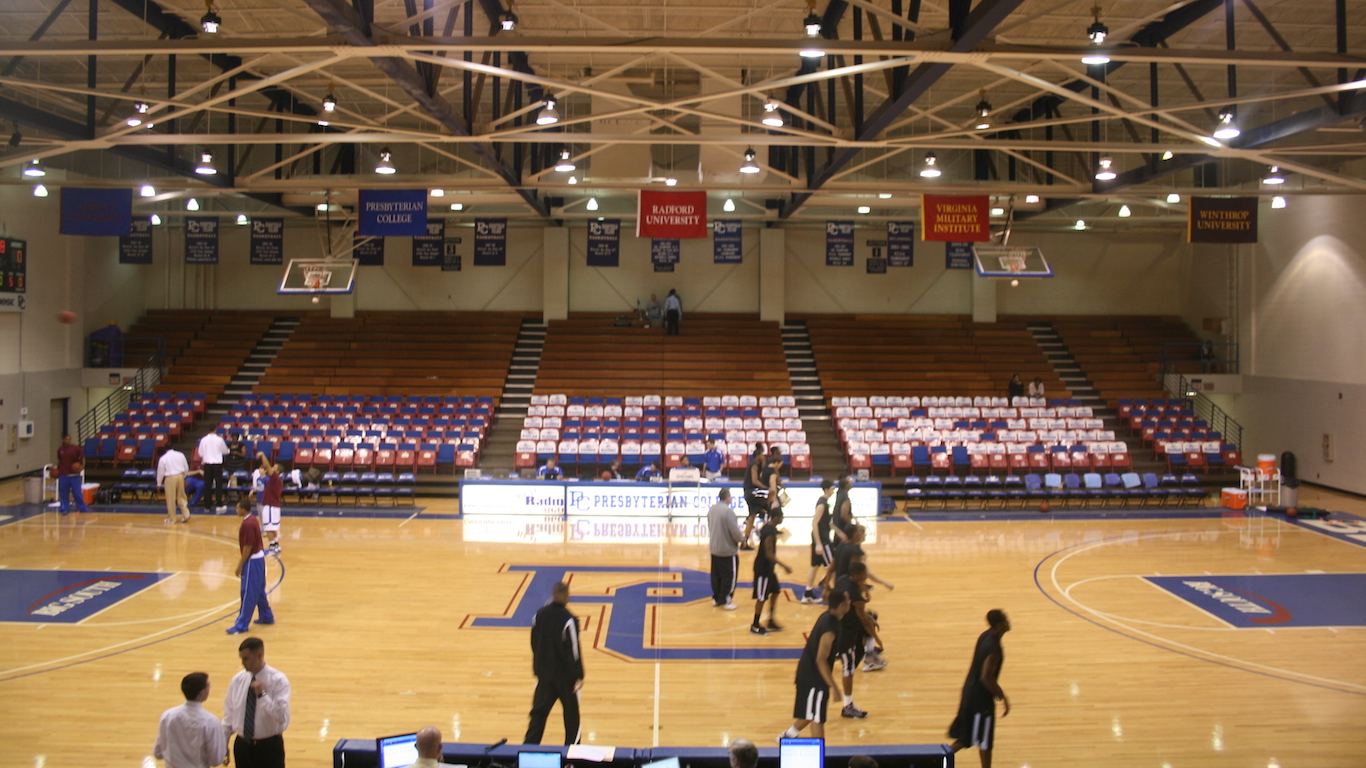
40. Clinton, South Carolina
> Town median household income: $29,342
> State median household income: $45,483
> Town poverty rate: 36.4%
> Town population: 8,561
The typical household in Clinton earns just $29,342 a year, less than both the $45,483 state and $53,889 national median incomes. Nearly 24% of residents in the town are on the SNAP welfare program, compared to 15% of all South Carolina residents statewide. The earnings potential of area residents is likely limited by a low high school graduation rate. Just 76% of Clinton adults have a high school diploma, less than the 86% comparable state education attainment rate.
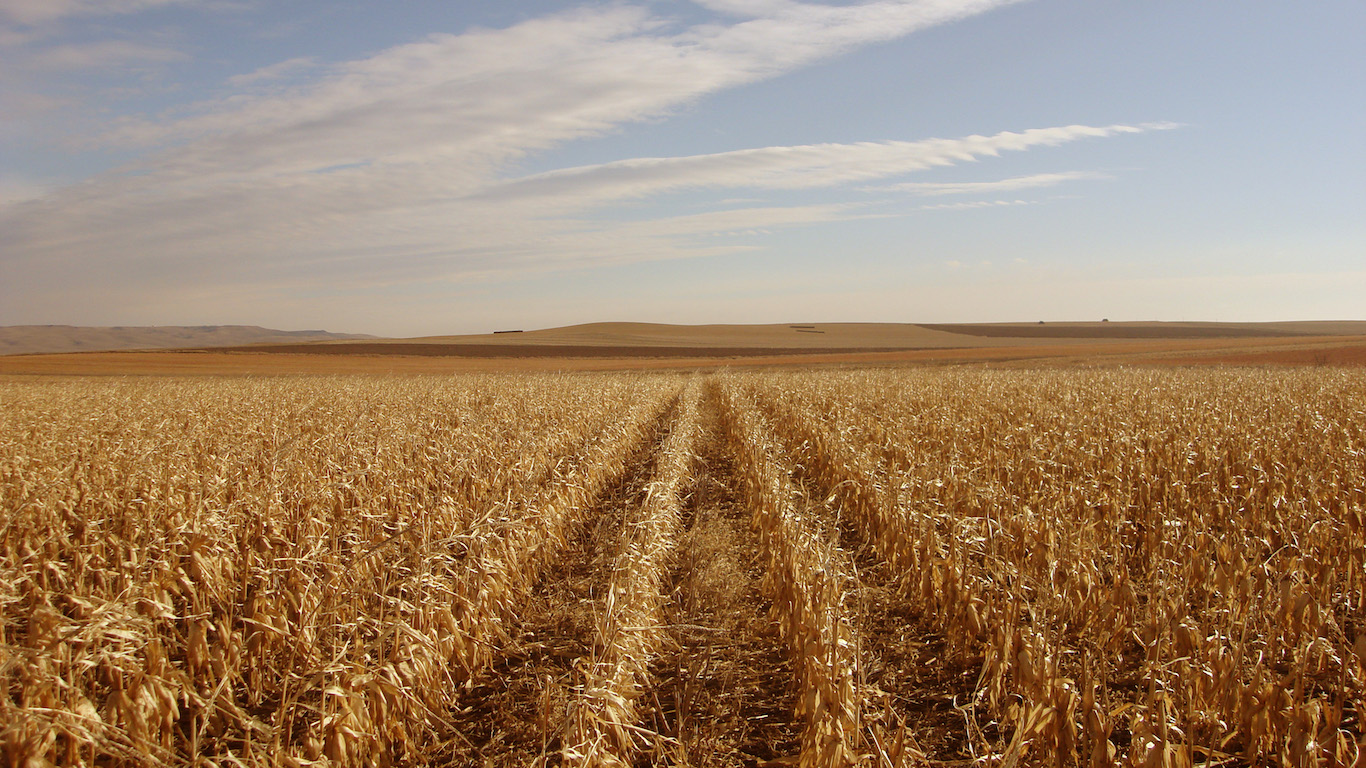
41. Winner, South Dakota
> Town median household income: $34,331
> State median household income: $50,957
> Town poverty rate: 28.6%
> Town population: 2,855
The median household income in Winner is just $34,331 a year, roughly $17,000 less than the statewide median income of $50,957. An estimated 28.6% of the town’s population lives in poverty, a larger share than the 14.1% state and 15.5% national poverty rates. With such low incomes, many town residents rely on government assistance to meet their basic needs. Roughly 22% of Winner residents receive SNAP benefits, twice the corresponding state figure of 11%.
[in-text-ad]
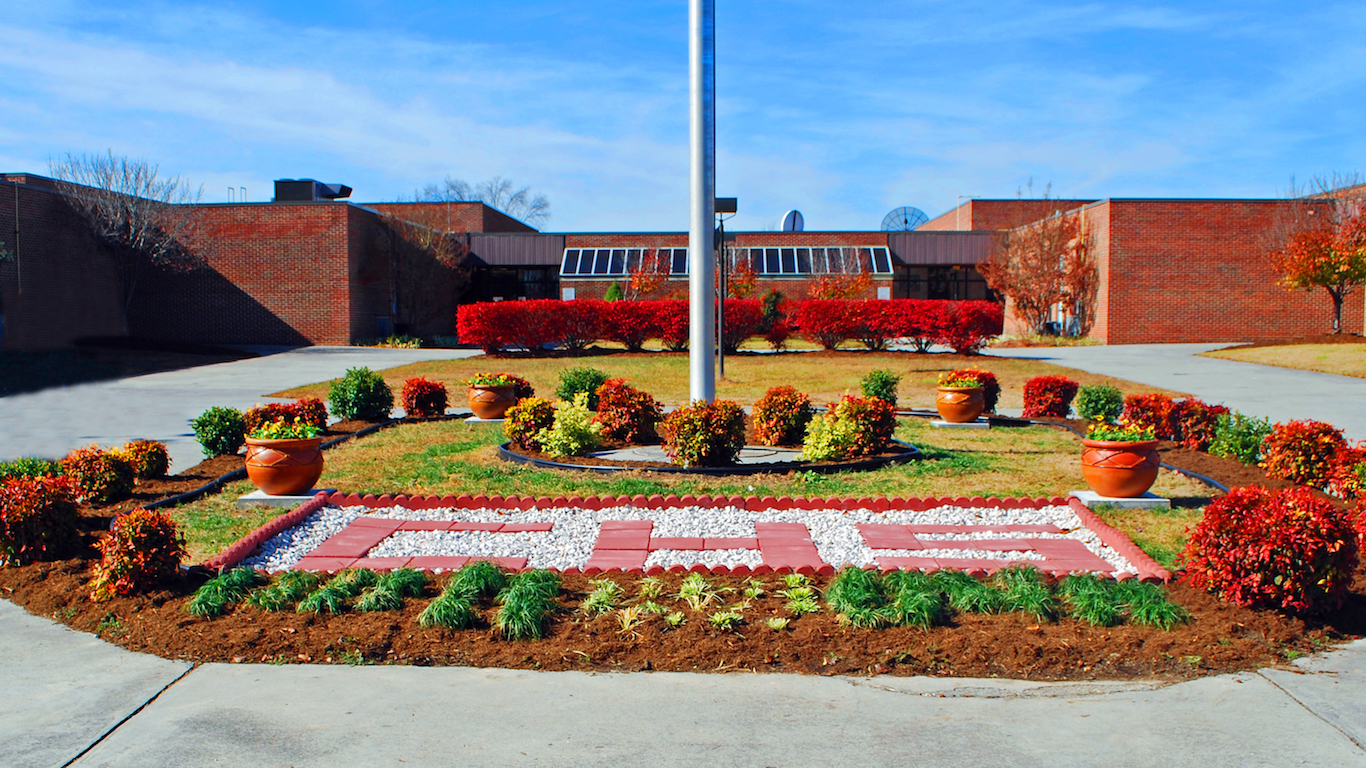
42. Rogersville, Tennessee
> Town median household income: $25,095
> State median household income: $45,219
> Town poverty rate: 26.6%
> Town population: 4,400
Rogersville is one of the poorest towns in the country, with a median household income of just $25,095 a year — less than half the national median income of $53,889. Like many low-income cities, relatively few Rogersville residents have a college education, which often lead to better earnings. Just 15% of area adults have a bachelor’s degree, roughly 10 percentage points less than the comparable state rate and half the national rate.
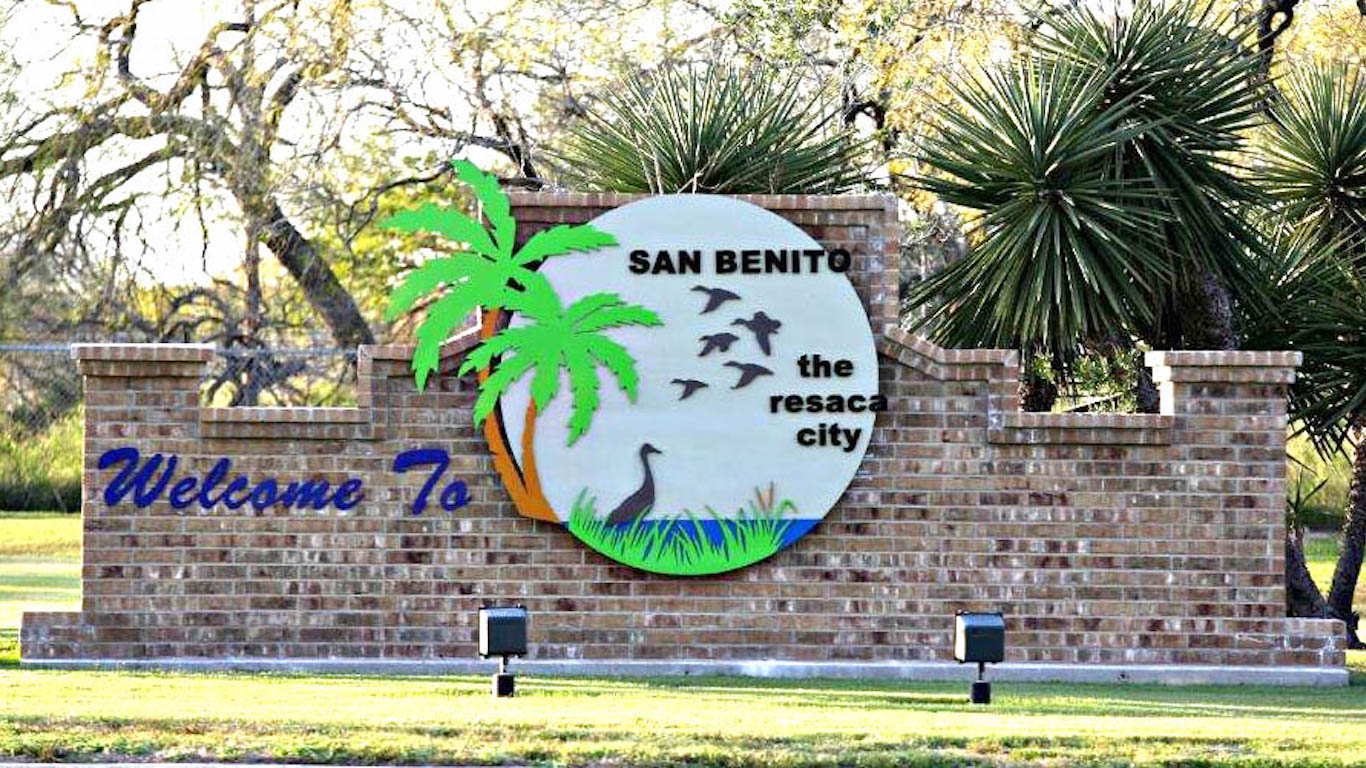
43. San Benito, Texas
> Town median household income: $26,158
> State median household income: $53,207
> Town poverty rate: 38.7%
> Town population: 24,486
Adults with greater educational attainment often earn higher salaries than those without a college degree. In San Benito, the poorest town in Texas, fewer than one in 10 adults have at least a bachelor’s degree — about a third of the comparable national bachelor’s degree attainment rate.
A smaller college-educated population is not the only obstacle to higher incomes in San Benito. For a variety of social and historic reasons, black and Hispanic populations tend to face greater challenges to upward income mobility than white residents in the United States, and nearly 94% of San Benito’s population are either Hispanic or Latino.
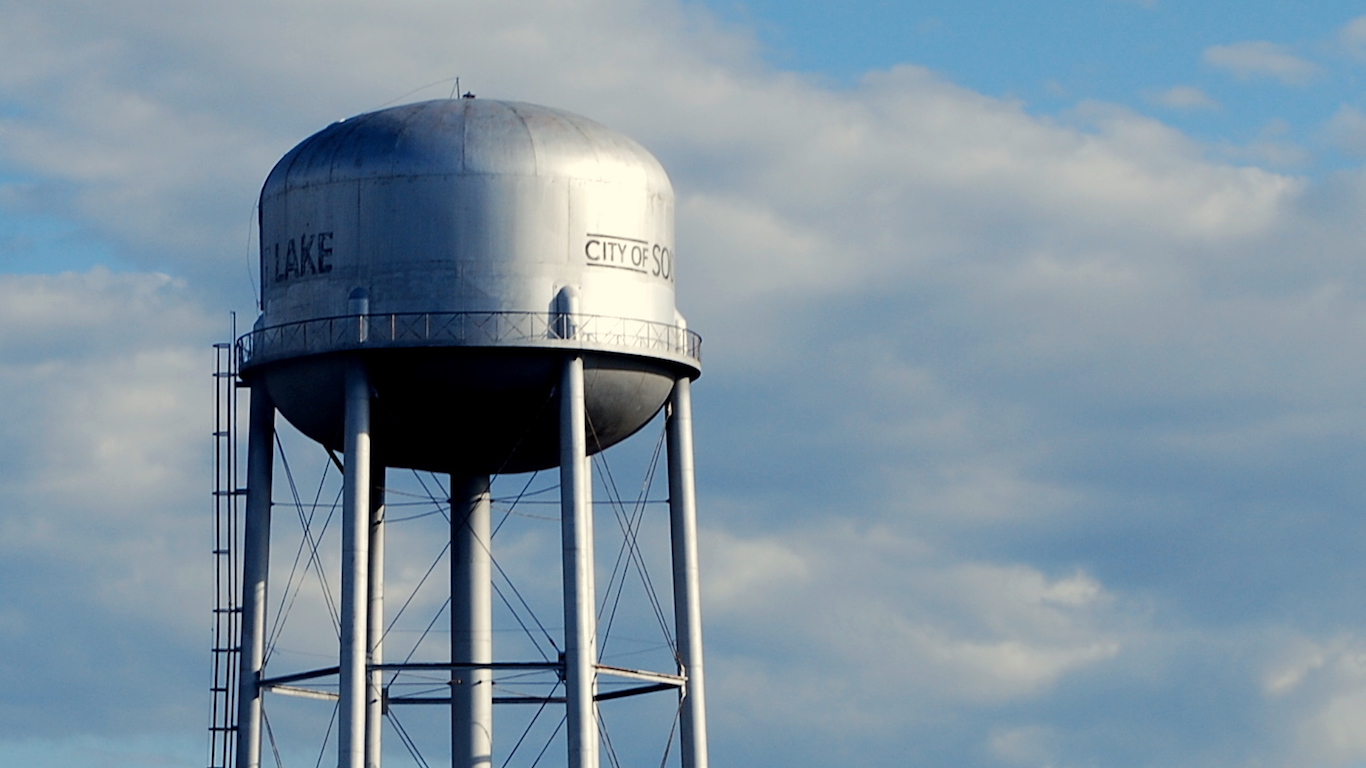
44. South Salt Lake, Utah
> Town median household income: $37,083
> State median household income: $60,727
> Town poverty rate: 26.8%
> Town population: 24,501
A poor section of Salt Lake City, South Salt Lake is also the poorest town in Utah. Not only are incomes lower in South Salt Lake than anywhere else in the state, but 27% of area residents live in poverty — at least 7 percentage points higher than the poverty rate of any other small town in Utah. As in many other towns on this list, adults in South Salt Lake are less likely to have completed high school or have a bachelor’s degree than adults across the state as a whole.
[in-text-ad-2]
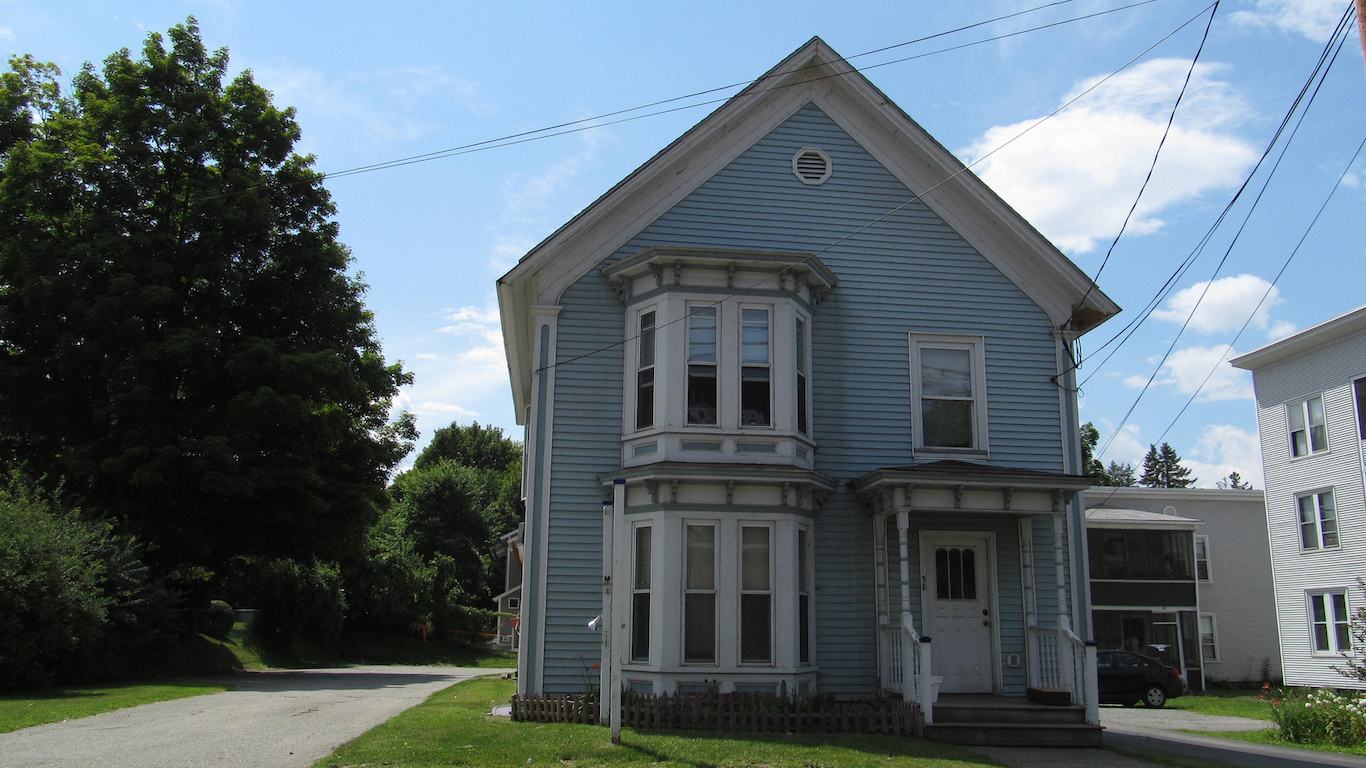
45. Newport, Vermont
> Town median household income: $30,101
> State median household income: $55,176
> Town poverty rate: 26.0%
> Town population: 4,493
Situated in northern Vermont, just south of the Canadian border, Newport is home to fewer than 5,000 people. With a median household income just over $30,000 a year, Newport is also the poorest town in the state. The town’s 26.0% poverty rate is more than double the statewide 11.5% poverty rate.
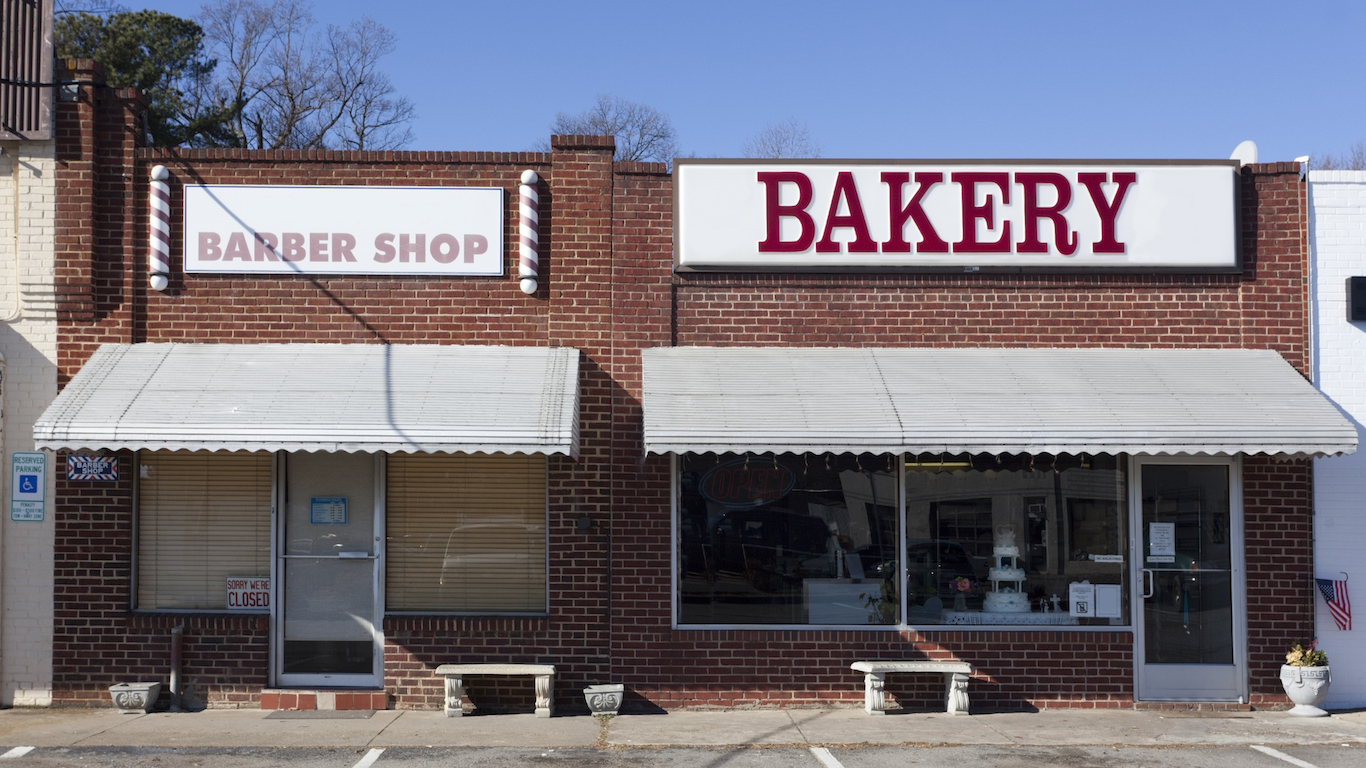
46. Collinsville, Virginia
> Town median household income: $34,382
> State median household income: $65,015
> Town poverty rate: 16.9%
> Town population: 7,507
The typical Collinsville household earns just $34,382 annually, far less than the median household income across the United States of $53,889. While the median household income in Collinsville is nearly $20,000 less than the national figure, the town’s struggle with poverty is not as severe as in cities at similar earnings levels. Some 16.9% of Collinsville residents live in poverty, just 1.4 percentage points more than the 15.5% national poverty rate.
[in-text-ad]
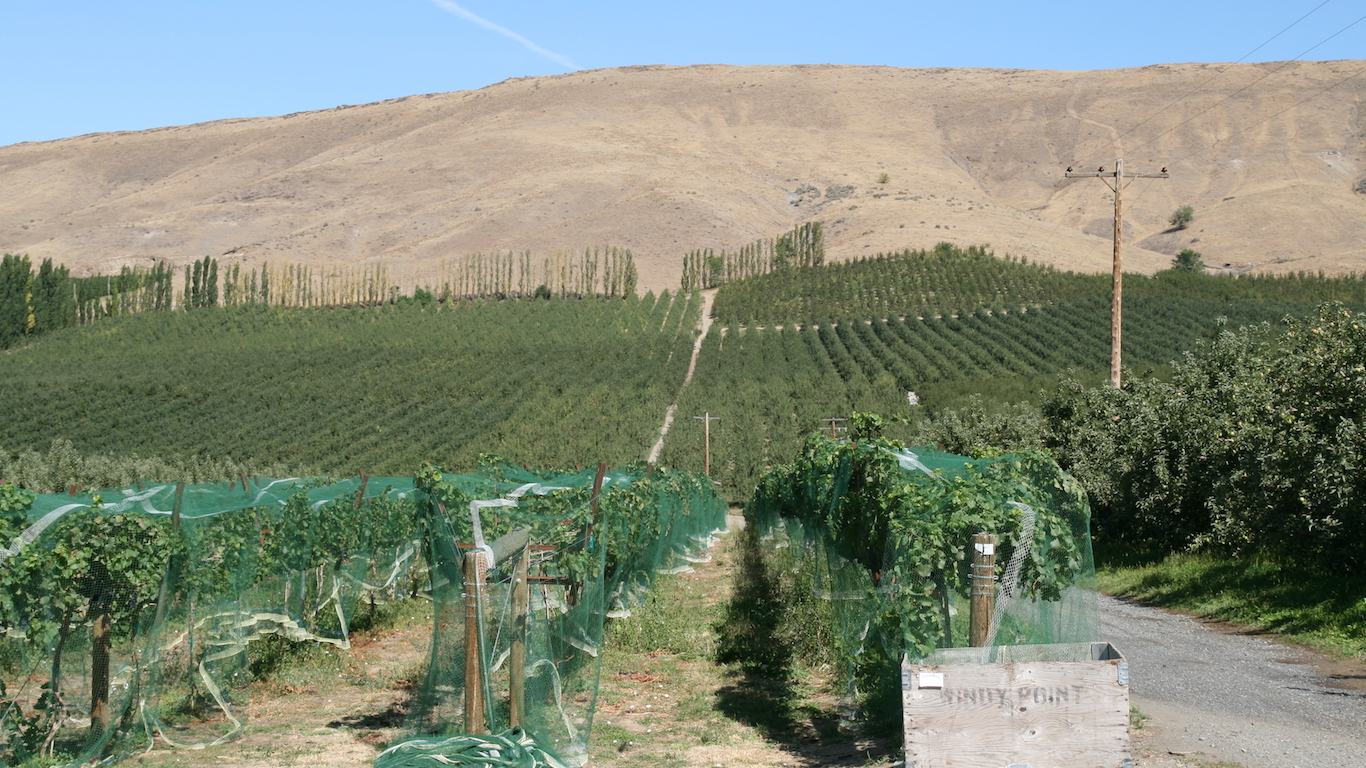
47. Wapato, Washington
> Town median household income: $32,722
> State median household income: $61,062
> Town poverty rate: 36.6%
> Town population: 5,075
The demographics of Wapato have changed dramatically since World War II, when members of the town’s once-populous Japanese community were either interned or expelled, and guest workers from Mexico were welcomed through the Bracero Program. Today, Hispanic and Latino residents comprise more than 85% of the population. Many of the jobs in Wapato are low-paying agricultural positions, likely keeping area incomes low. The typical Wapato household earns just $32,722 annually, about $28,300 less than the state median income of $61,062. More than one-third of Wapato residents live in poverty.
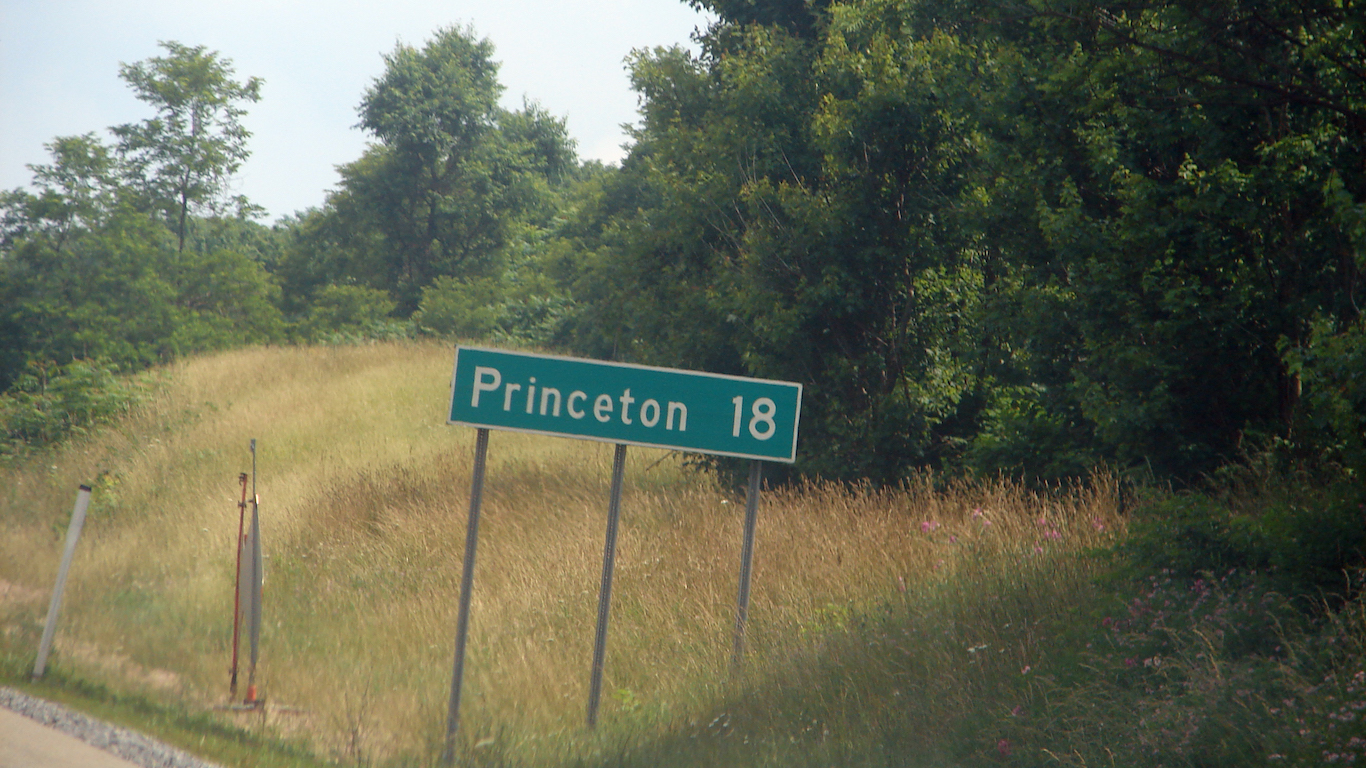
48. Princeton, West Virginia
> Town median household income: $30,856
> State median household income: $41,751
> Town poverty rate: 31.6%
> Town population: 6,082
Once a key stop along the historically significant Virginia Railway, the population of Princeton has fallen steadily from its peak of 8,393 in 1960 to just 6,082 as of 2015. The area’s economy has declined along with the nation’s coal mining industry, and today Princeton is the poorest town in West Virginia. The typical household earns just $30,856 annually, roughly $11,000 less than the statewide median household income of $41,751. Only one of West Virginia’s 10 small towns — Bethlehem — has a median household income above the $53,889 national median.
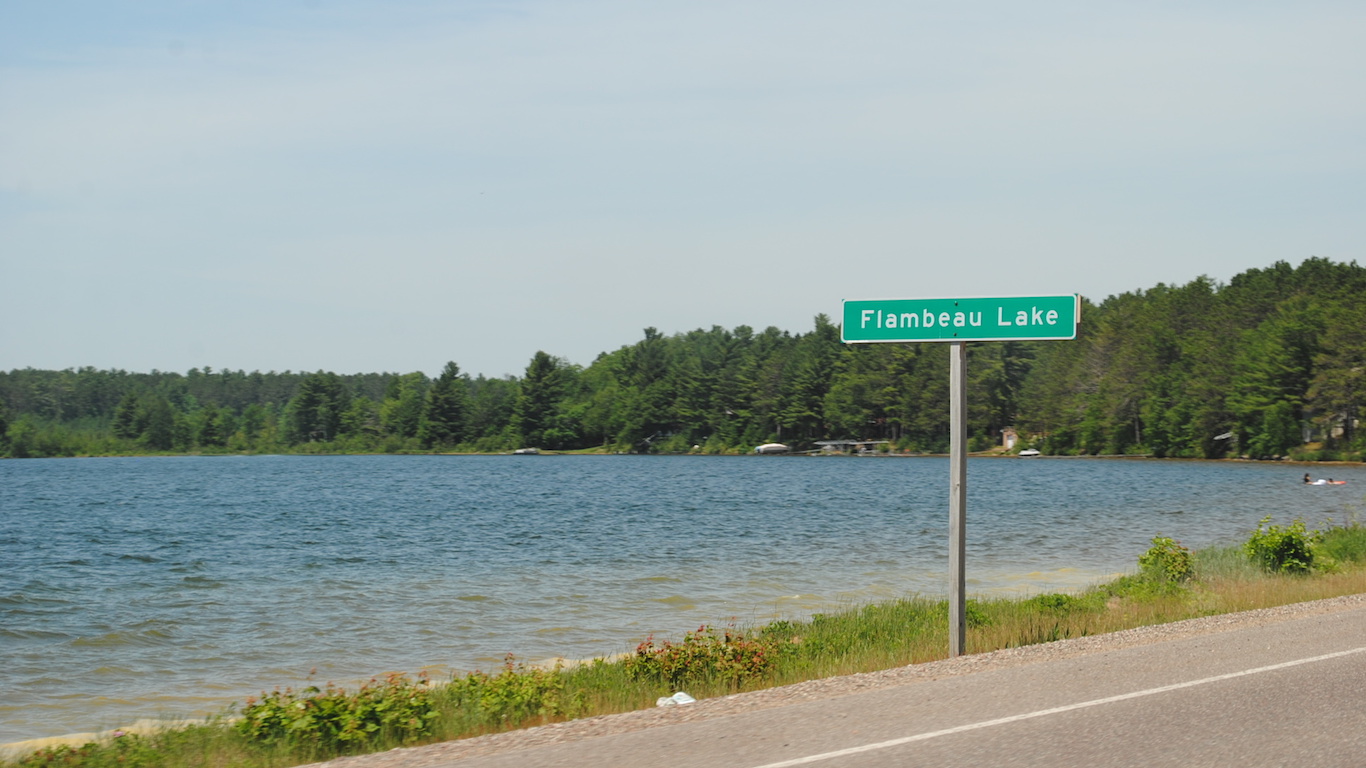
49. Lac du Flambeau, Wisconsin
> Town median household income: $20,160
> State median household income: $53,357
> Town poverty rate: 44.3%
> Town population: 1,739
An American Indian reservation in northern Wisconsin, Lac du Flambeau has the lowest median household income in the state. Native Americans face considerable historic and economic disadvantages in the United States. In Lac du Flambeau, 76% of the 1,739 residents are American Indian, and 44.3% of residents live in poverty — the largest share in the state.
[in-text-ad-2]
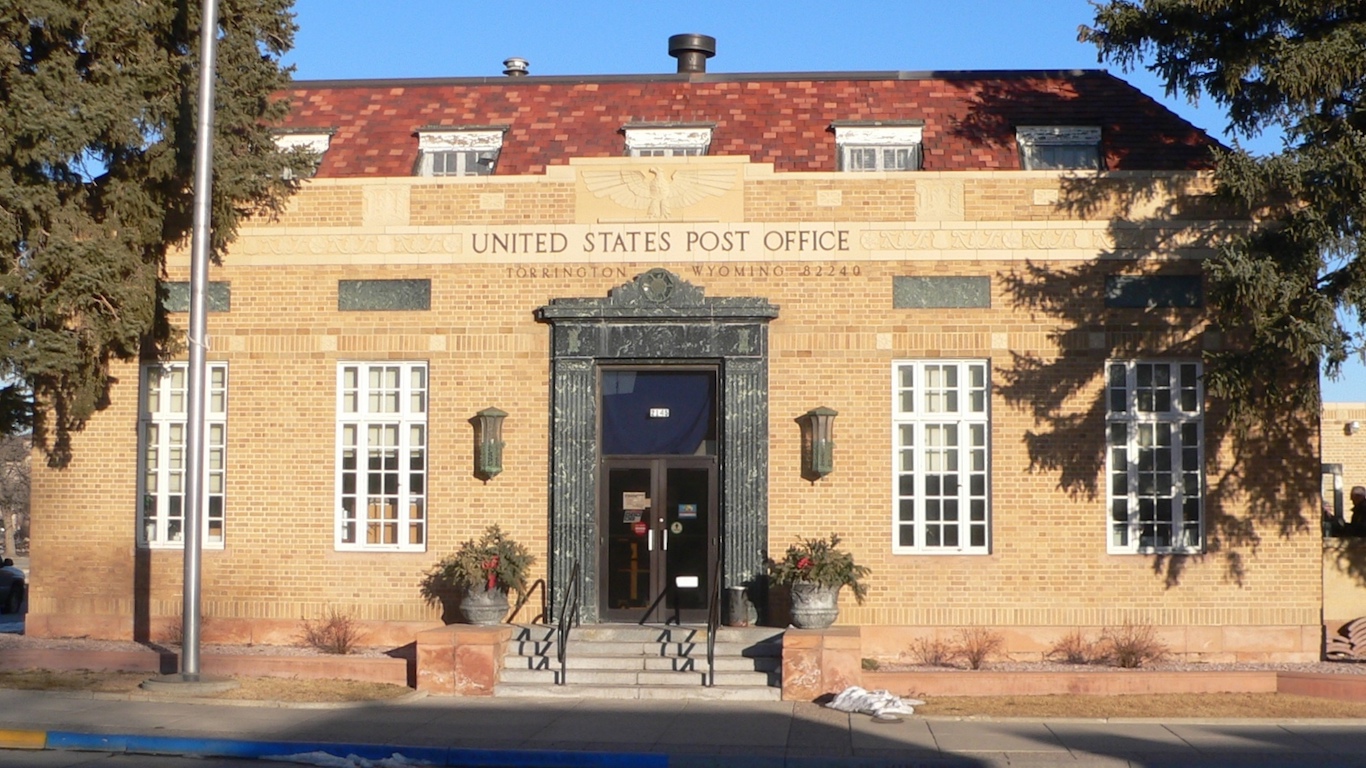
50. Torrington, Wyoming
> Town median household income: $40,911
> State median household income: $58,840
> Town poverty rate: 20.9%
> Town population: 6,736
Torrington is the only small town in Wyoming where more than one in four residents live in poverty. Despite low incomes, only about 9.7% of the population rely on food stamps, a smaller share than the national 13.2% food stamp recipiency rate. Additionally, 90.6% of Torrington residents have graduated from high school — a slightly higher share than the 86.7% of American adults.
If you’re one of the over 4 Million Americans set to retire this year, you may want to pay attention.
Finding a financial advisor who puts your interest first can be the difference between a rich retirement and barely getting by, and today it’s easier than ever. SmartAsset’s free tool matches you with up to three fiduciary financial advisors that serve your area in minutes. Each advisor has been carefully vetted, and must act in your best interests. Start your search now.
Don’t waste another minute; get started right here and help your retirement dreams become a retirement reality.
Thank you for reading! Have some feedback for us?
Contact the 24/7 Wall St. editorial team.